Georgia is home to many species of snakes. There are 40 species of non venomous snakes in the state. There are just 6 that are both venomous and dangerous to humans.
We will go over the nonvenomous snakes first before moving on to the venomous species.
We hope this helps you learn what snakes may live near you.
- Non venomous snakes
- Eastern Green Water Snake
- Brown Water snake
- Plain-bellied Water Snake
- Banded Water snake
- Northern Water Snake
- Queen Snake
- Striped Crayfish Snake
- Glossy Crayfish Snake
- Black Swamp Snake
- Brown Snake
- Florida Brown Snake
- Red-bellied Snake
- Eastern Ribbon Snake
- Common Garter Snake
- Smooth Earth Snake
- Rough Earth Snake
- Eastern Hognose Snake
- Southern Hognose Snake
- Ringneck Snake
- Eastern Worm Snake
- Pine Woods Snake
- Mud Snake
- Rainbow Snake
- Black Racer
- Coachwhip
- Rough Green Snake
- Corn Snake
- Eastern Rat Snake
- Gray Rat Snake
- Pine Snake
- Common Kingsnake
- Black King snake
- Mole King snake
- Scarlet King snake
- Eastern Milk Snake
- Scarlet Snake
- Southeastern Crowned Snake
- Florida Crowned Snake
- Eastern Indigo Snake
- Brahminy Blind Snake (non-native)
- Venomous Snakes
Non venomous snakes
All of these snakes are considered harmless to humans. Most lack venom entirely, but a few species have venom that can’t harm a human.
At worst snake bites may cause swelling and pain at the site of the bite.
Never handle a wild snake and be careful if you are walking in areas that may have a snake. Many species will hide under leaf litter.
If you step on a snake you didn’t see, it may bite you in self-defense.
Eastern Green Water Snake
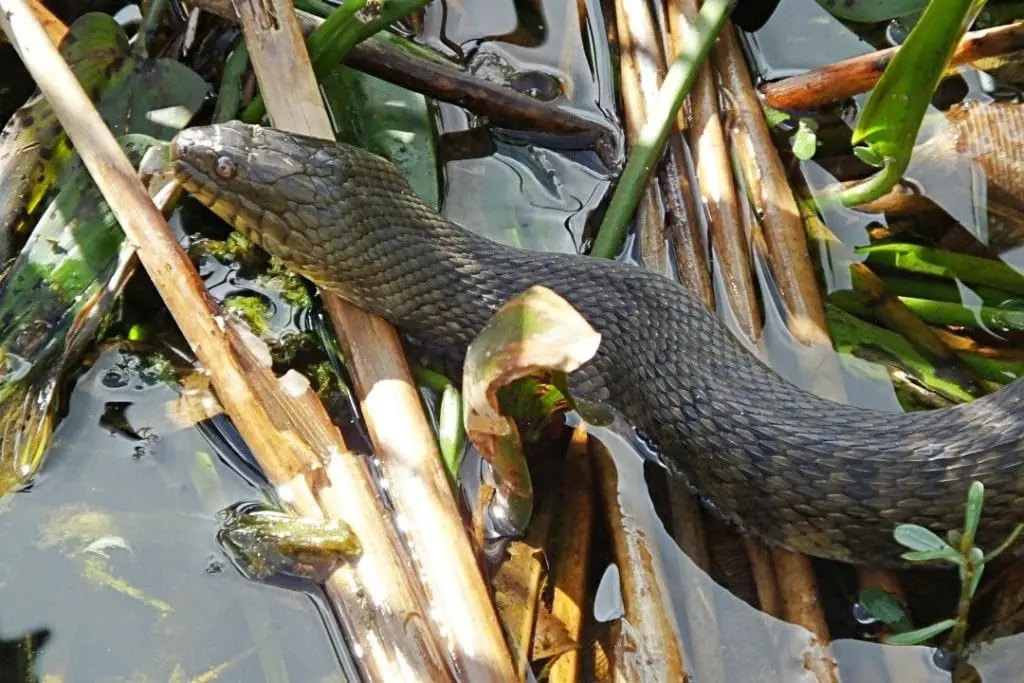
The Eastern green water snake (Nerodia floridana) is found primarily near the border with Florida, but there is a small population near the border with South Carolina.
These snakes are between 30 and 55 inches long as adults. They are a solid greenish-brown as adults with a light belly.
Juveniles have dark bars that fade with age.
Water snakes in the Nerodia genus are rarely found far from water. They prefer still water like lakes, swamps, marshes, and very slow rivers.
These snakes are diurnal and primarily eat aquatic prey such as amphibians and fish.
Brown Water snake
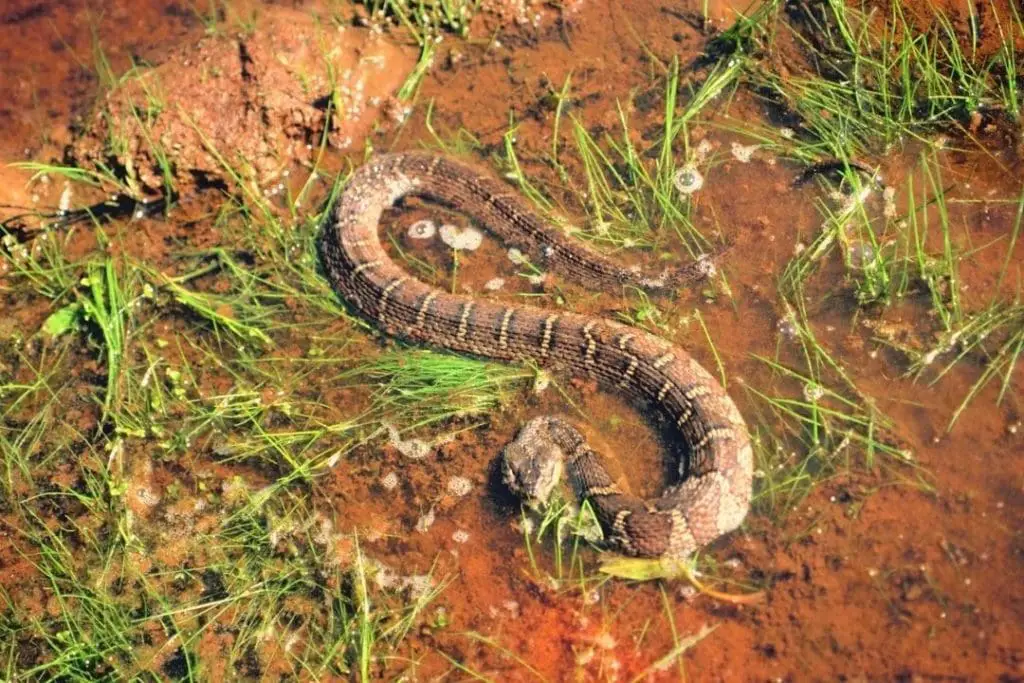
The brown water snake (Nerodia taxispilota) is found over much of Georgia aside from the north of the state.
This non venomous snake is easily confused for the venomous cottonmouth. These snakes are between 30 and 60 inches long.
Brown water snakes are typically light to dark brown with large square blotches that are a darker brown than the background.
They have light bellies with brown blotches and black crescents.
They can be told apart from cottonmouths by having round pupils and eyes that are set high on the head.
Their heads are narrower than other watersnakes in the area. They prefer moving water that stays year-round.
They rarely go far from water and eat fish. They are very good at climbing and may be found up to 20 feet above the water where they bask on branches.
Plain-bellied Water Snake
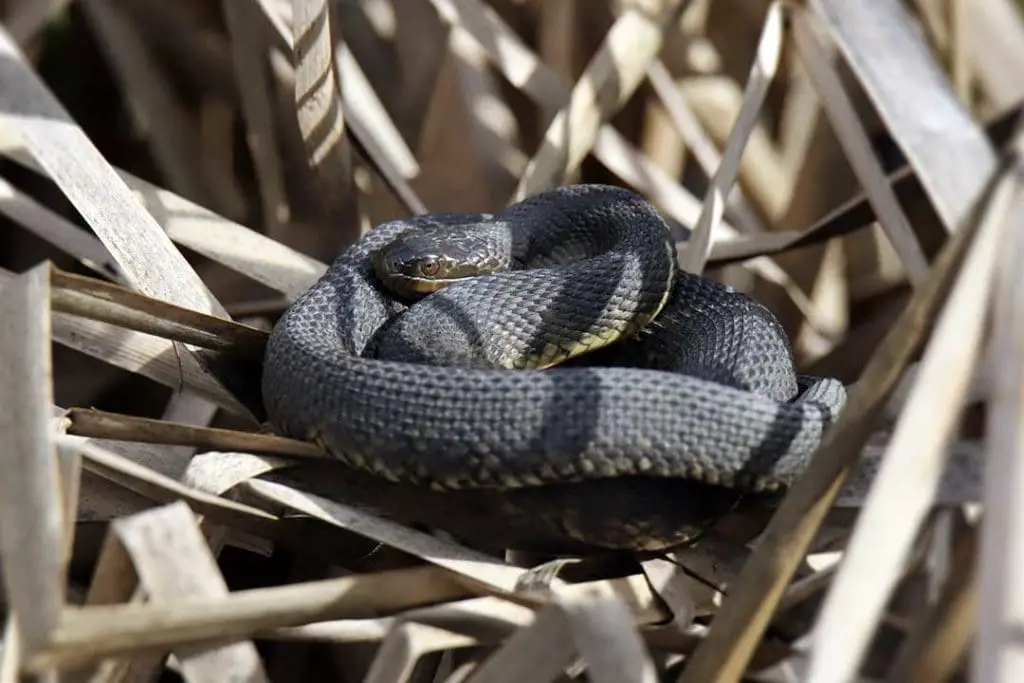
The plain-bellied watersnake (Nerodia erythrogaster) is found over most of Georgia aside from the mountainous areas and the southeast of the state.
These snakes are also called the red-bellied watersnake and may have other names depending on the exact subspecies.
They are 30-48 inches as adults and are dark brown, light brown, or gray. They have orange to yellow bellies. Juveniles are light brown to pinkish with blotches along the body.
They prefer living near rivers, creeks, lakes, and swamps. They eat primarily amphibians but will also eat fish on occasion.
They typically bask near water and are unique among the watersnakes since they will flee onto land if approached instead of into the water.
Banded Water snake
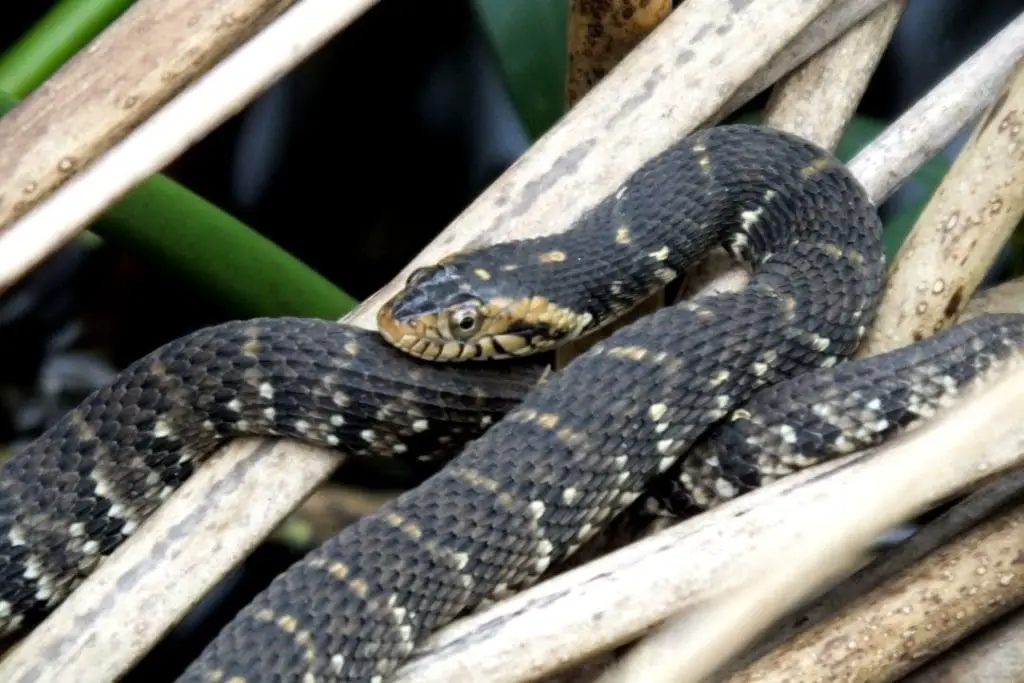
The banded watersnake (Nerodia fasciata) is found mostly in the south of the state.
They are between 24 and 48 inches long as adults.
They can be light brown or reddish to black in their main color. They also have crossbands that are wide on the back and become narrower on the sides.
They are found in nearly all freshwater habitats in the Coastal Plains region.
They prefer to bask on logs or branches over the water and may be seen hunting in the water for fish and amphibians.
Northern Water Snake
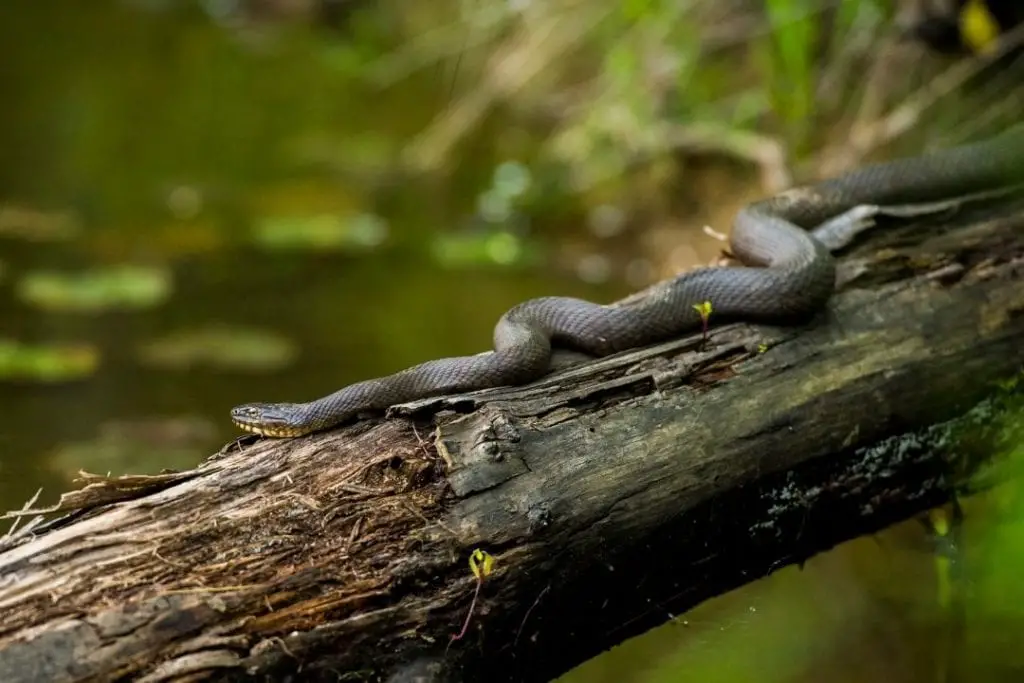
The Northern water snake (Nerodia sipedon) is restricted to the Piedmont and mountains.
They can be 24 to 55 inches long. These snakes can be tan, brown, or grayish. They have squarish blotches on the back and sides that alternate but may form bands.
Younger georgia snakes are typically brighter in color. They can be found in many aquatic habitats such as lakes, rivers, and marshes.
The northern watersnake will eat aquatic prey like fish and amphibians. While they can be confused with the cottonmouth, these snakes do not share their range with the cottonmouth.
Queen Snake

The queen snake (Regina septemvittata) is found in the mountains, parts of the Piedmont, and some river drainages in the Coastal Plains.
They are under 24 inches long as adults and have a grayish background color that may be olive or brown in tone.
They have light stripes down the sides and a yellow belly with four brown stripes that join at the tail.
These snakes live solely in running water with plenty of rocks. They eat newly-molted crayfish almost exclusively.
They are seen more often than the other crayfish snakes and lack the “bug-eyed” appearance.
Striped Crayfish Snake
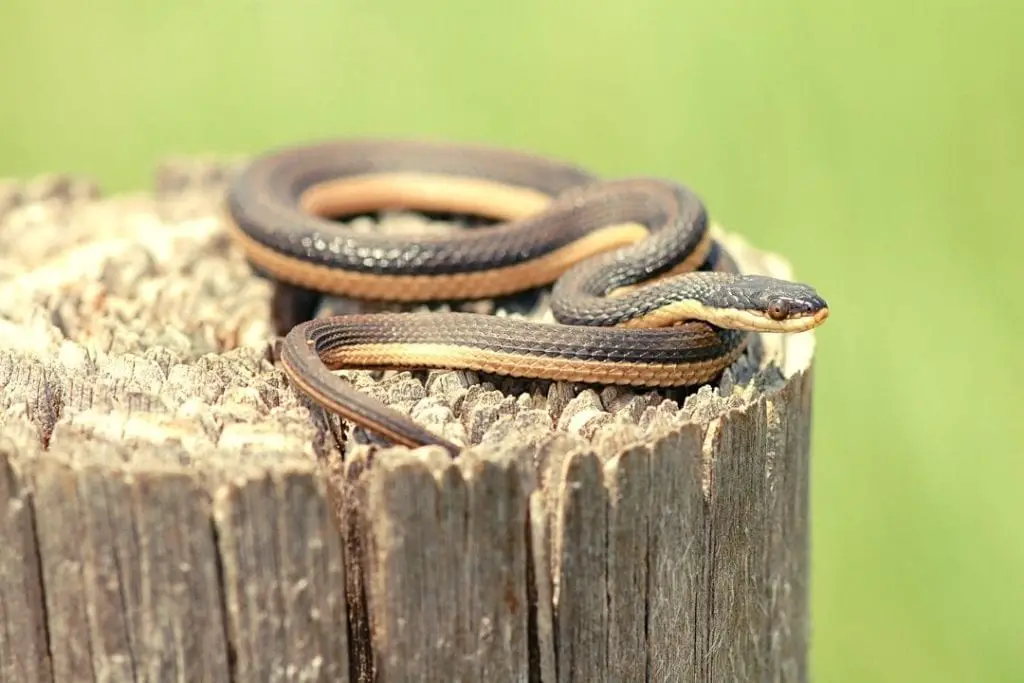
The striped crayfish snake (Regina alleni) is found only in the extreme south of Georgia. Striped crayfish snakes are small and will only be between 14 and 20 inches long as adults.
They are brown to green with shiny scales and stripes down the body. They have a yellow to orange belly with dark spots down the center.
They can be told apart from the glossy crayfish snake since the glossy crayfish snake has two rows of spots on the belly.
They can be found in cypress stands, swamps, bogs, and even beds of water hyacinth. They eat hard-shelled crayfish as adults, but juveniles will also eat dragonfly naiads and shrimp.
Glossy Crayfish Snake
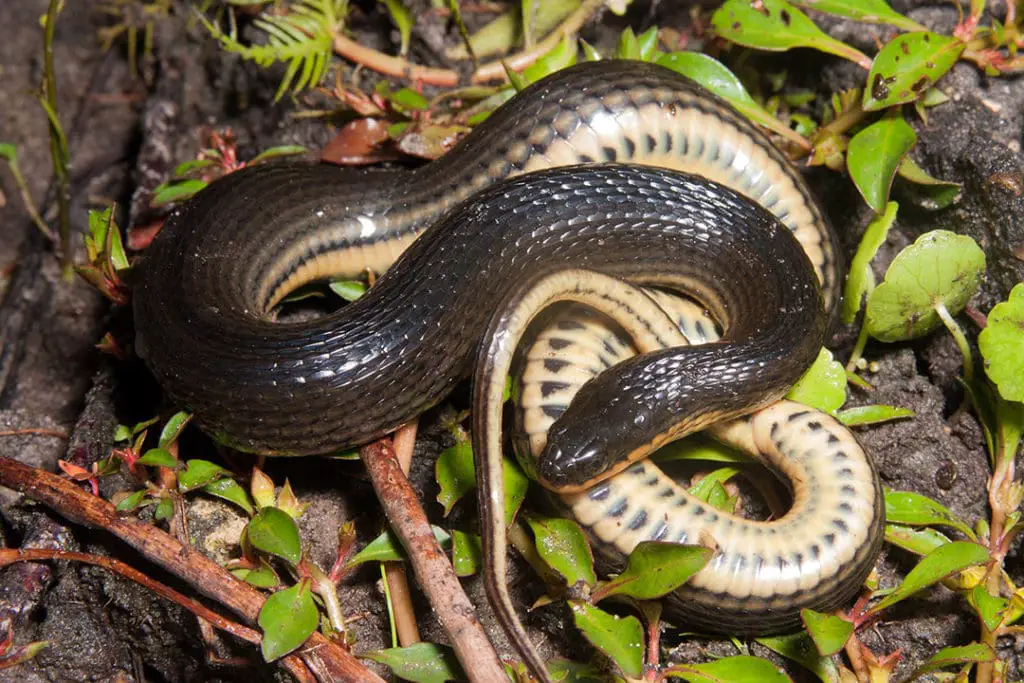
The glossy crayfish snake (Regina rigida) is found in the Coastal Plain. They are between 14 and 20 inches long and have short heads with large eyes. They are brown to olive with shiny scales.
They have light bellies with two rows of dark spots. They can be found in cypress swamps, ditches, and the margins of lakes and ponds.
They eat hard-shelled crayfish that they consume alive. This species is vulnerable to habitat loss. Thanks to how secretive these snakes are, it is unknown what the actual population is.
Black Swamp Snake
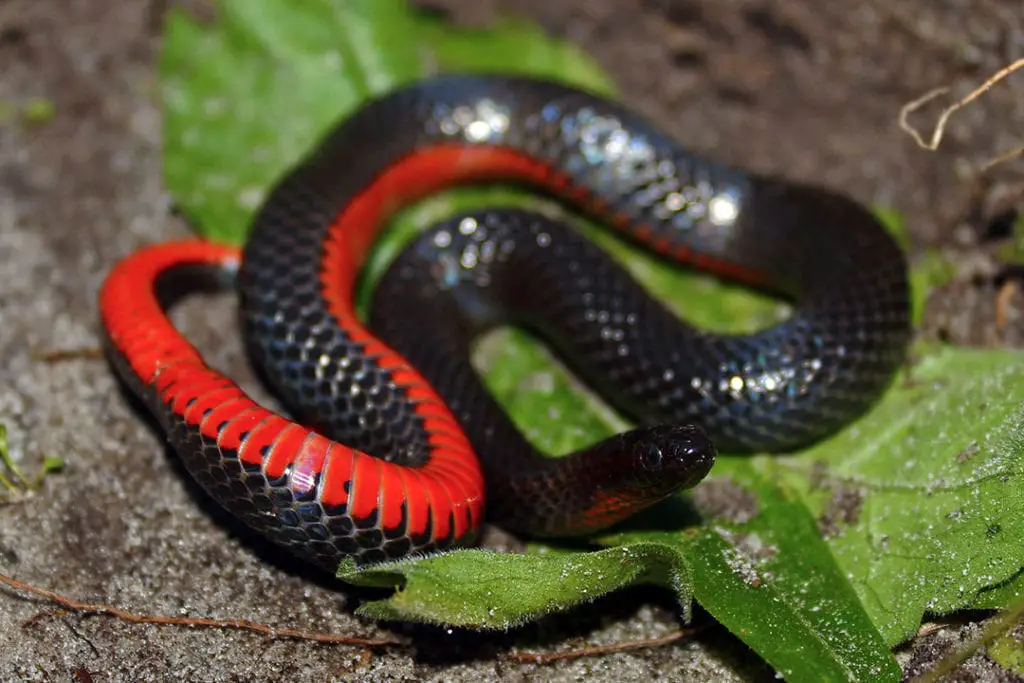
The black swamp snake (Seminatrix pygaea) that lives in the south and southeast of Georgia on the Coastal Plains.
They are under 22 inches long as adults and have a glossy black back with an unpatterned red belly. They prefer open aquatic habitats with plenty of vegetation.
They eat small fish, amphibians, and leeches. They heavily prefer habitats with fewer fish and more amphibians.
This means they tend to have a restricted range. This makes them vulnerable to habitat loss.
Brown Snake
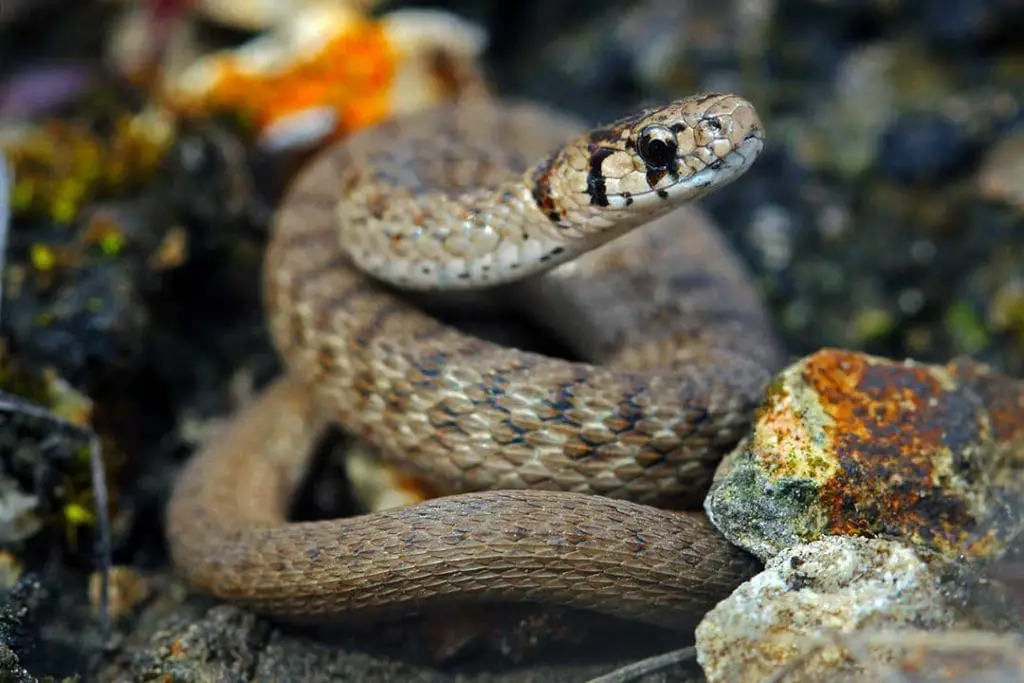
The brown snake (Storeria dekayi) is also known as DeKay’s brown snake.
They are found over virtually all of Georgia aside from the extreme south where it is replaced with the Florida brown snake.
They are only 6-13 inches long and are brown with rows of dark spots down the back. The belly is light brown to white.
They can be found in woodlands, wet areas, and even close to residential areas. They eat soft-bodied invertebrates like slugs and worms.
Florida Brown Snake
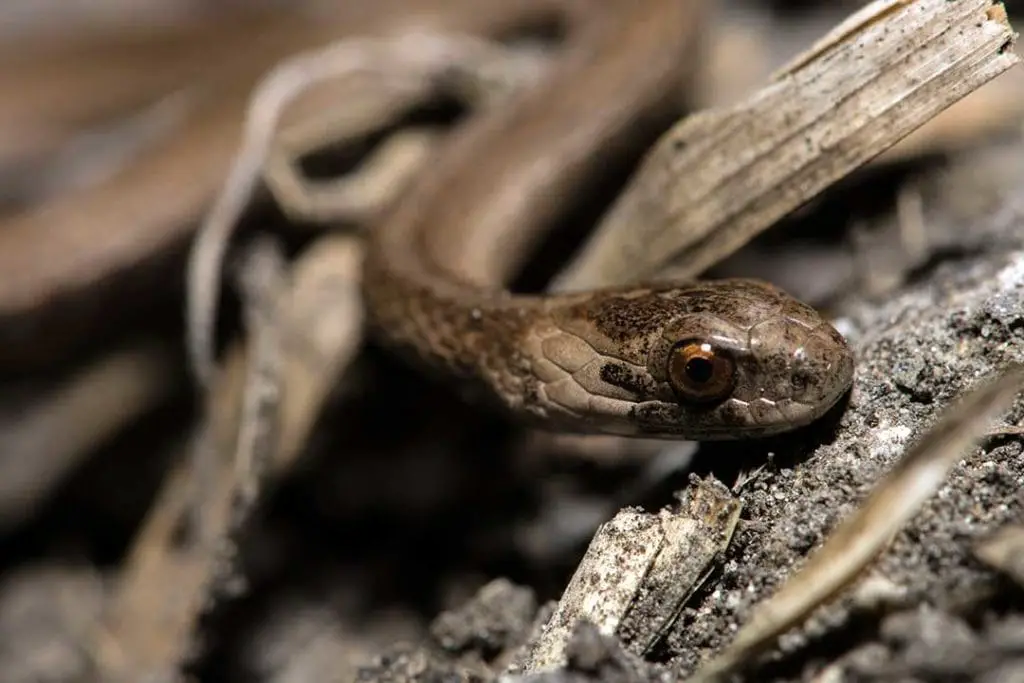
The Florida brown snake (Storeria victa) found in the southeast of Georgia. They are 9-13 inches long and can be brown to gray.
They look similar to the brown snake but have a light band around the neck. The belly is light and has spots along the sides of the belly.
They prefer moist habitats with plenty of ground cover. They also eat soft invertebrates. They may be a subspecies of the brown snake.
Red-bellied Snake
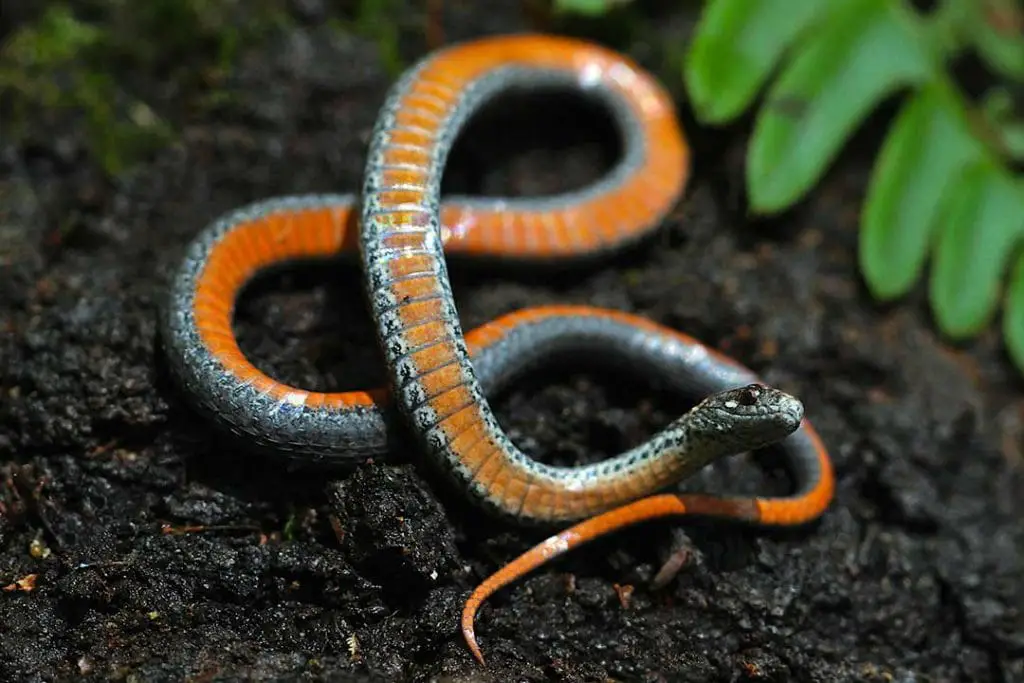
The red-bellied snake (Storeria occipitomaculata) or red bellied water snake is found over the entire state of Georgia.
They are 4-10 inches long and have a wide variety of colors on the back. They can be brown, gray, orange, black, or nearly any shade in between.
The easiest way to identify the species is the bright red to orange belly that lacks any patterning.
They prefer forested habitats but can be found in many habitats like fields or the margins of wetlands.
They eat slugs almost exclusively and will stick near areas with high concentrations of their prey.
Eastern Ribbon Snake
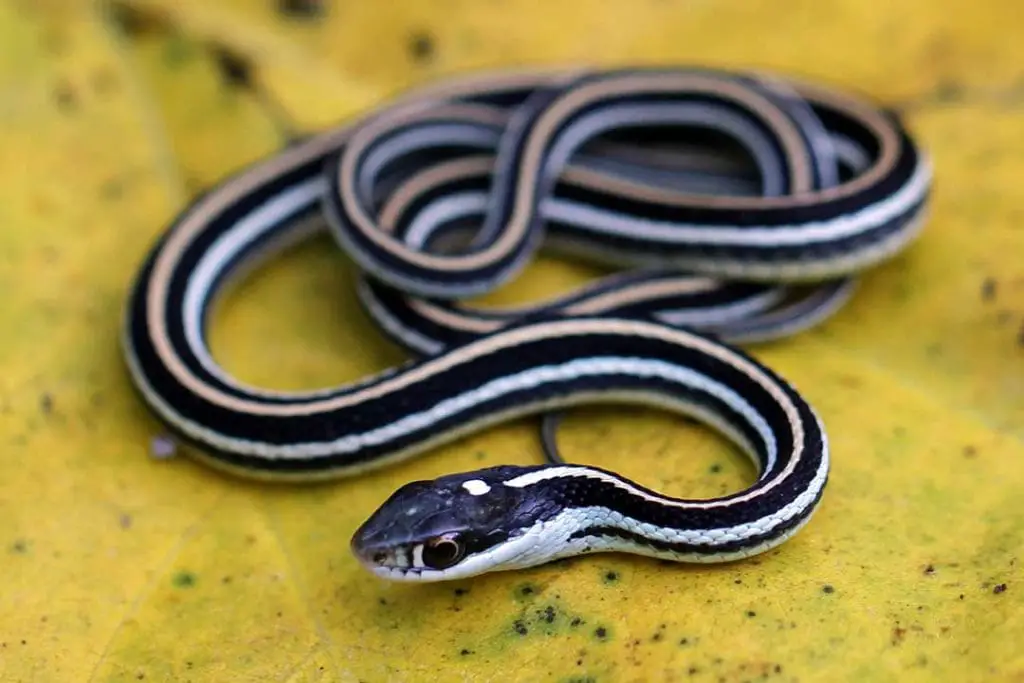
The Eastern ribbon snake (Thamnophis sauritis) is found over most of Georgia aside from the northwest of the state.
They are typically between 16-28 inches long. They have light stripes against a dark background.
They are easily confused with the common garter snake but have no marking on the lip scales and a light bar in front of the eyes.
They live near the edges of bodies of water and eat small fish and amphibians.
Common Garter Snake
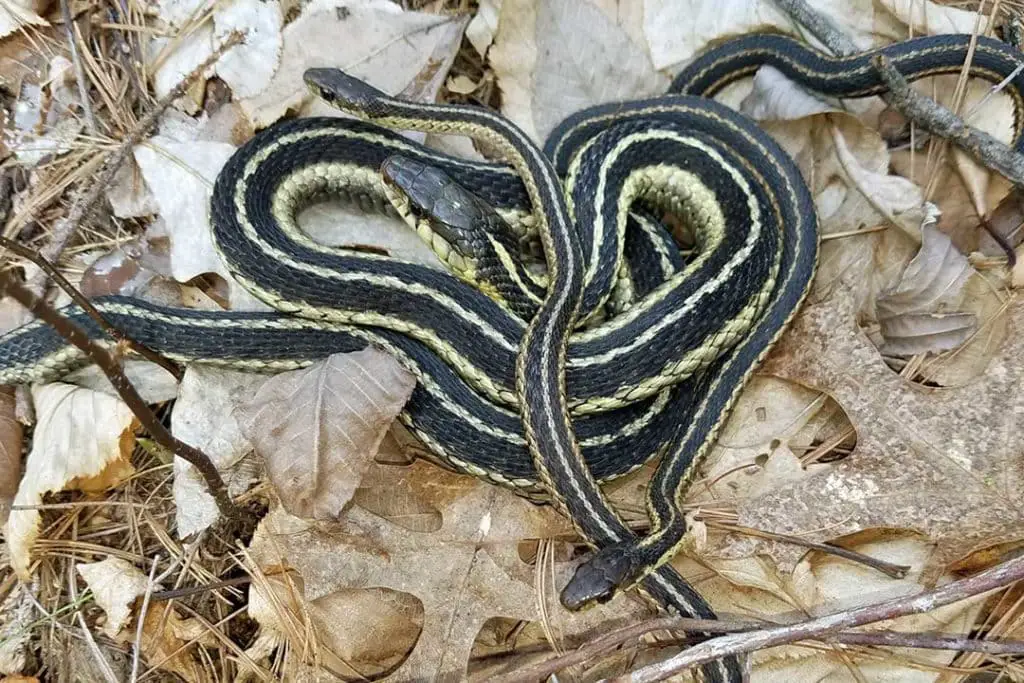
The common garter snake (Thamnophis sirtalis) is found over the entire state.
They are typically 16-28 inches long but can reach lengths of up to 49 inches.
They have three yellow stripes down the body that are over a dark background. They can have very different colors depending on where the snake is from.
Eastern garter snake and common garter snakes can be found in nearly every habitat and may be near homes if there is enough debris for them to hide in. These snakes do have mild venom.
It is rare for a bite to include enough venom to cause a reaction in humans. At most the bite will cause localized pain and swelling.
Smooth Earth Snake
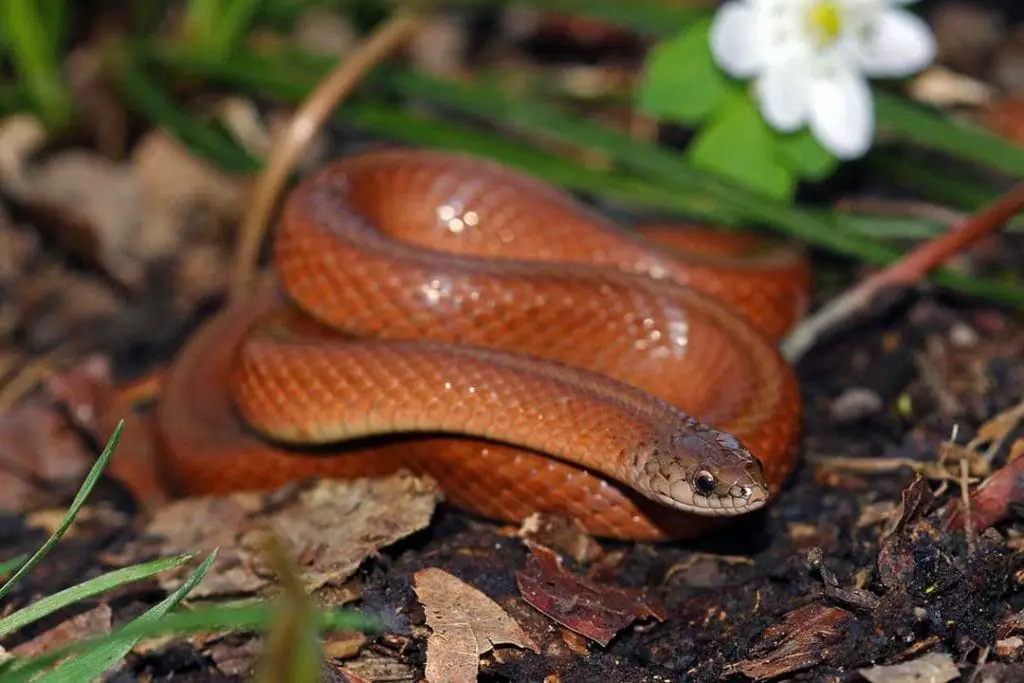
The smooth earth snake (Virginia valeriae) lives virtually all of Georgia aside from a small section in the southeast.
They are small at only 7-10 inches long. They have smooth scales and are brown to gray. They prefer woodland habitats.
Smooth earth snakes are burrowing animals and eat soft-bodied insects and earthworms.
Rough Earth Snake
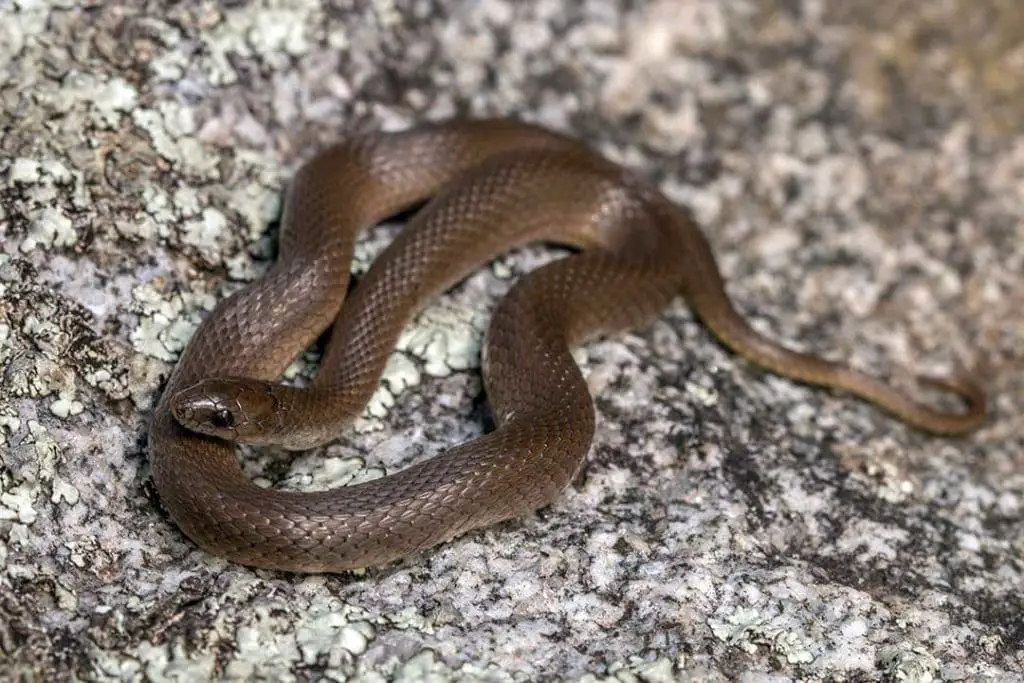
The rough earth snake (Haldea striatula) is found in the Coastal Plains aside from a small section of southwestern Georgia.
They are brown to gray with keeled scales. They prefer woodland habitats with plenty of ground cover.
Rough earth snakes are burrowing snakes that eat earthworms almost exclusively.
Eastern Hognose Snake
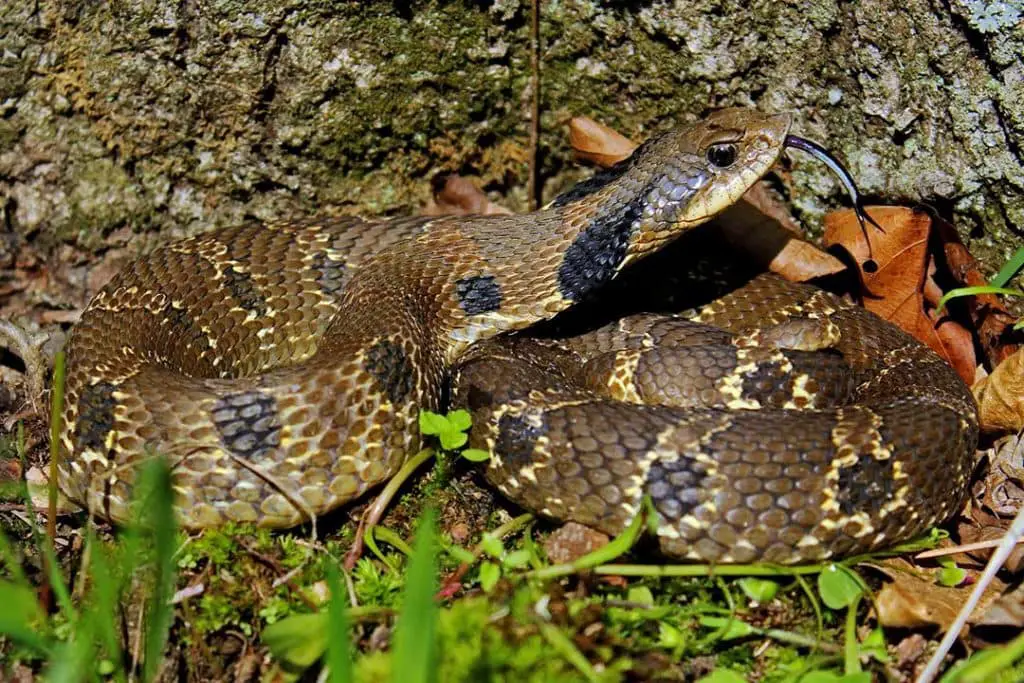
The Eastern hognose snake (Heterodon platirhinos) is found over the entire snake. They can be up to 46 inches long.
They come in a wide range of colors but can be distinguished by the upturned scale on the snout. These snakes live in a wide range of habitats.
Eastern hognose snakes are only found in areas with sandy soil.
They are sometimes called puff adders because of their defensive behavior of puffing up, flattening their hides, and striking with the mouth closed.
If this doesn’t work, Eastern hognoses will turn over and play dead. They eat a wide range of prey but prefer toads.
They have large rear fangs to puncture puffed-up toads and are immune to the poisons their prey produces.
Southern Hognose Snake
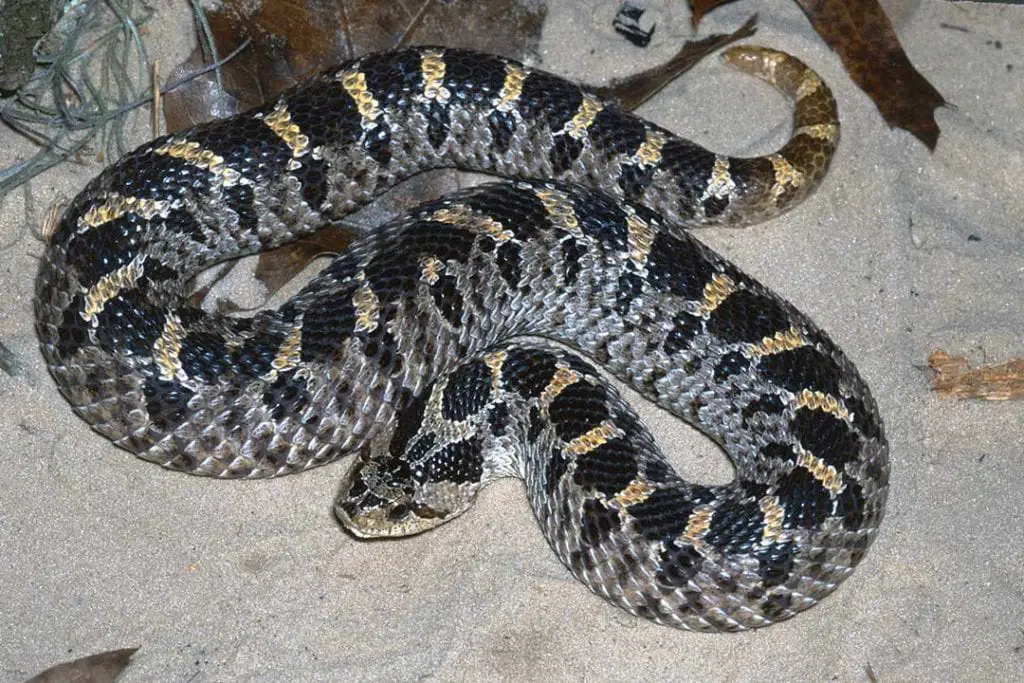
The Southern hognose (Heterodon simus) is found in most of Georgia aside from the north of the state. Due to habitat loss, they are becoming very rare.
They are up to 24 inches long and come in gray, reddish, or tan with dark blotches.
They are found only in sandhill, pine flatwood, and coastal dune habitats.
They have similar defensive behavior to the Eastern hognose and also prefer to eat toads.
Ringneck Snake
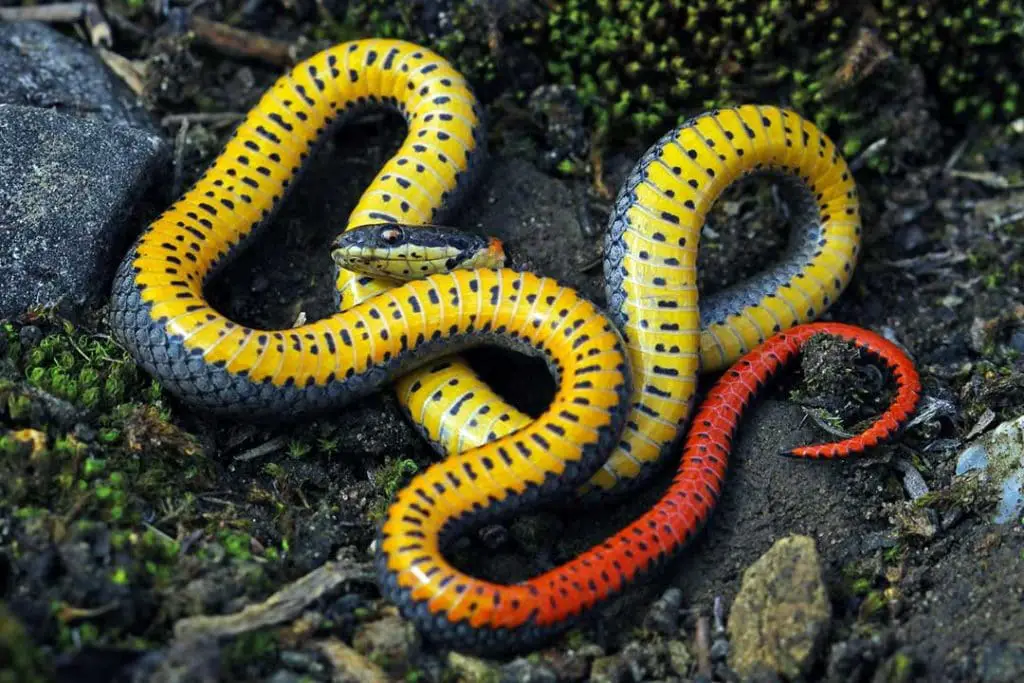
The ringneck snake (Diadophis punctatus) has two subspecies that cover the entire state.
The northern ringneck snake (D. p. edwardsii) is found in the mountains while the southern ringneck snake (D. p. punctatus) is found in the Coastal Plains.
Both subspecies average 10-15 inches long with a gray back and an orange band and belly. The northern ringneck has a complete ring and unpatterned underside.
The southern has a broken ring and patterning on the belly. They live in woodlands and eat small prey like invertebrates, small snakes, lizards, and amphibians.
Eastern Worm Snake

The Eastern worm snake (Carphophis amoenus) is found primarily in the Piedmont but can also be found in the mountains.
Worm snakes stay under 13 inches long and live almost entirely underground. They are brown snakes with shiny scales and tiny eyes.
They eat earthworms almost exclusively like other burrowing snakes.
Pine Woods Snake
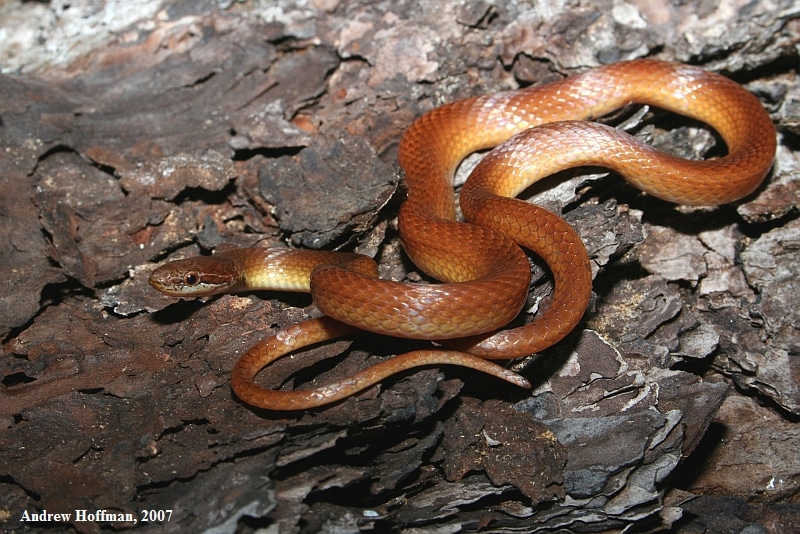
The pine woods snake (Rhadinaea flavilata) is found rarely in Georgia with its range restricted to the southeast of the state.
They are 10-13 inches long and are generally some shade of brown.
They are fossorial or burrowing and prefer woodland habitats or the margins of wetlands.
Mud Snake
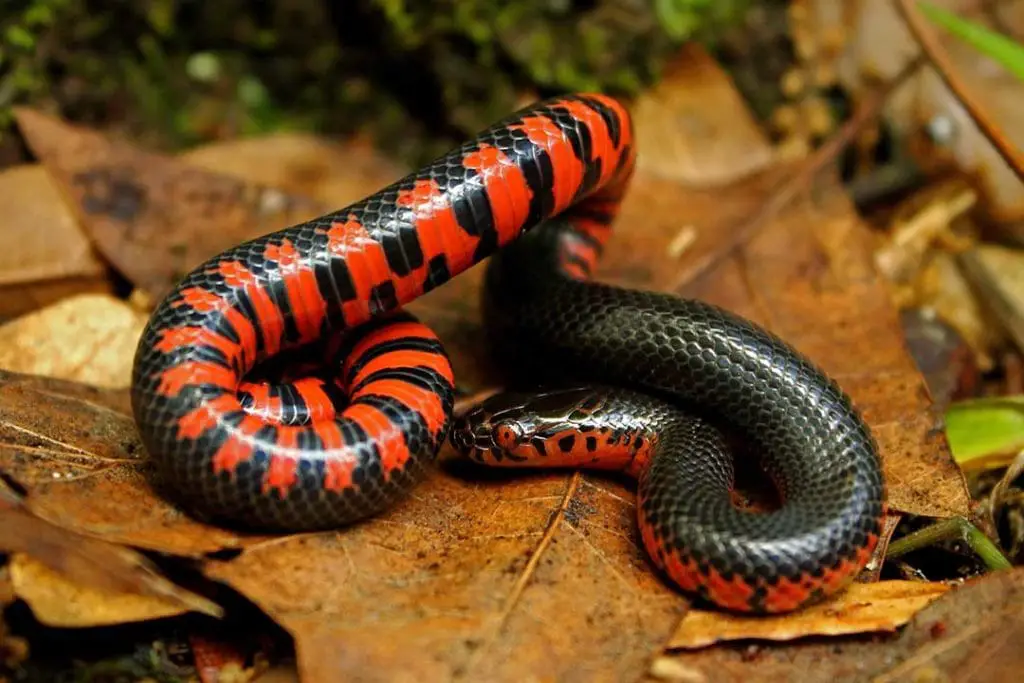
The mud snake (Farancia abacura) is found on the Coastal Plain and the Piedmont in the west of Georgia.
They are up to 81 inches long and have a glossy black back. The belly is a red or pink and black checkerboard. They prefer aquatic habitats with plenty of vegetation.
Young snakes can be found in temporary wetlands while adults typically move to permanent bodies of water.
They are rarely seen outside of the water. Adults eat giant aquatic salamanders while young snakes will also eat salamander larvae and tadpoles.
Rainbow Snake
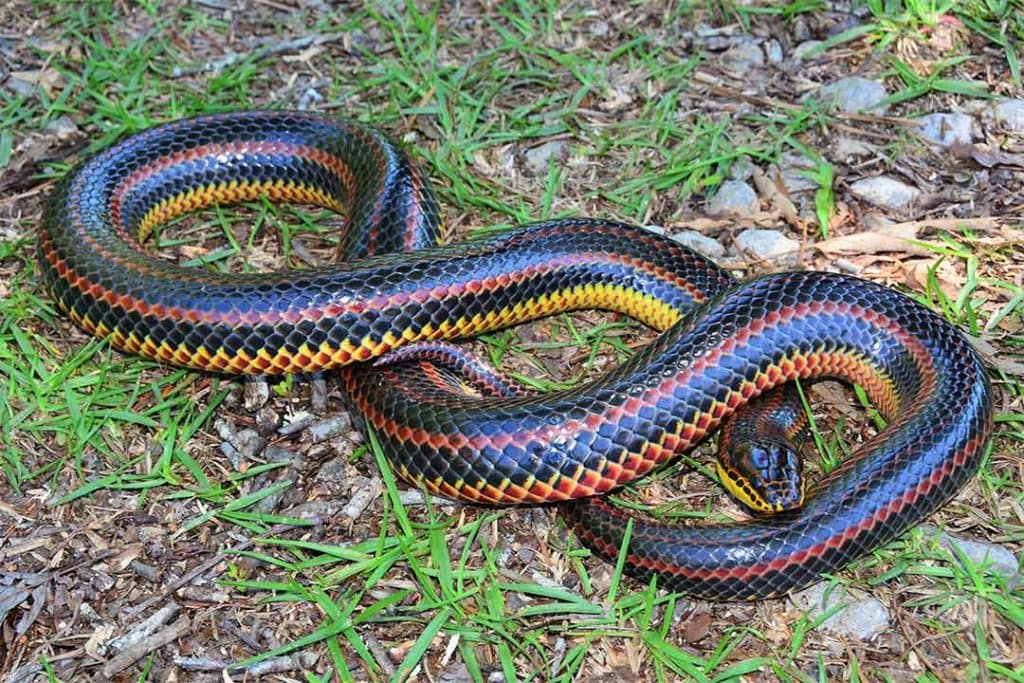
The rainbow snake (Farancia erytrogramma) is found in the Coastal Plains of Georgia. They are large and can reach sizes of up to 66 inches long.
Their back is glossy black with three red stripes that run down it. The belly is red or pink with two or three rows of black spots.
There can be yellow on the sides of the animal. They prefer aquatic habitats with flowing water. Young snakes eat fish, amphibians, and earthworms while adults only eat the American eel (Anguilla rostrata).
Black Racer
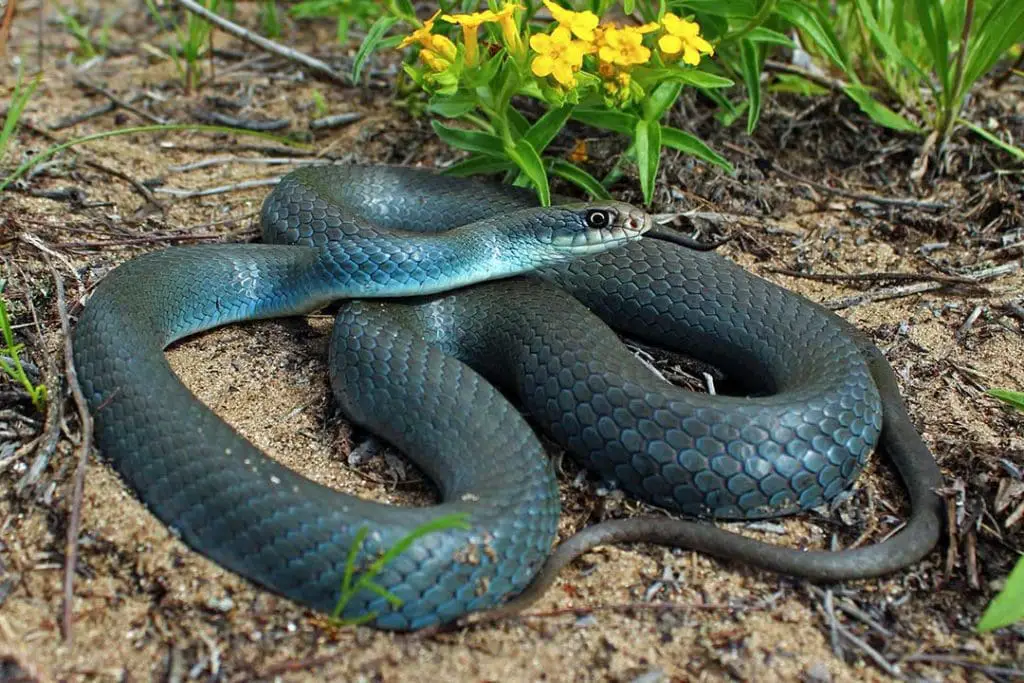
The black racer (Coluber constrictor) are very common to the whole state of Georgia and are typically the most common snake in nearly any habitat.
They can reach up to 60 inches long and are a solid black as adults. Young black racers look nothing like adults. They can be gray or brown and have brown or reddish blotches along the body.
They have very large eyes as juveniles and can be told apart from other dark snakes in the region by their habit of fleeing or striking if approached.
Other common snakes will freeze up first. They are diurnal and use their good eyesight to hunt a wide variety of prey.
Coachwhip
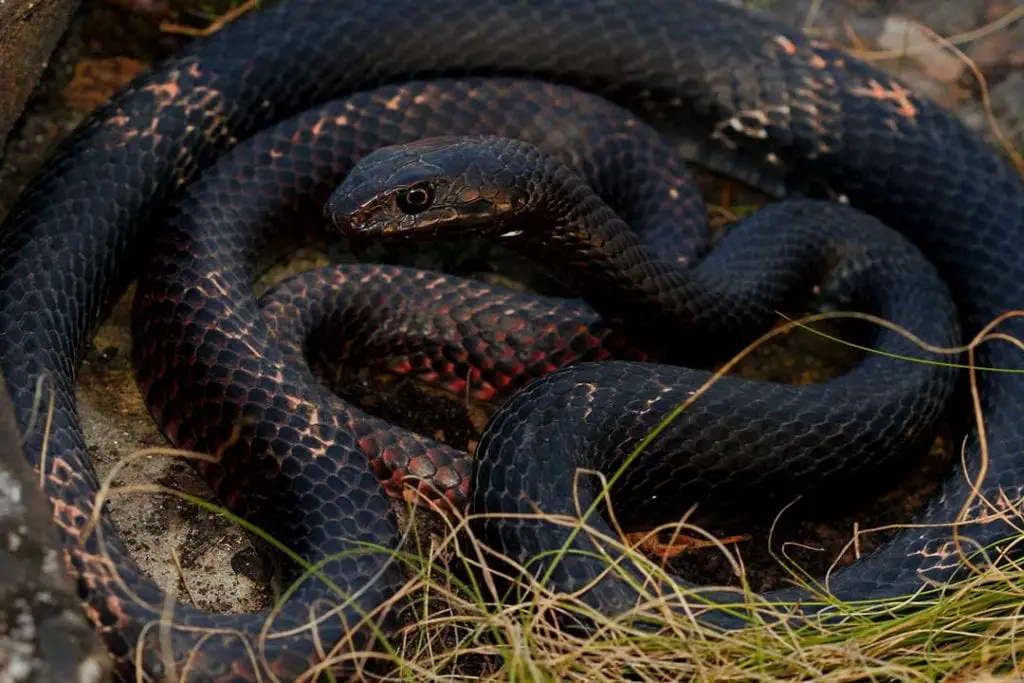
The coachwhip (Masticophis flagellum) is a large snake found over all of Georgia aside from the northern mountains.
They can be over 8 feet long and have black heads that fade from tan along the body to nearly white at the tip of the tail.
Young snakes are tan with irregular banding. They prefer open habitats with sandy soil. They are active hunters with good vision that hunt down a wide variety of prey.
They prefer lizards and can even catch skinks and racerunners.
Rough Green Snake
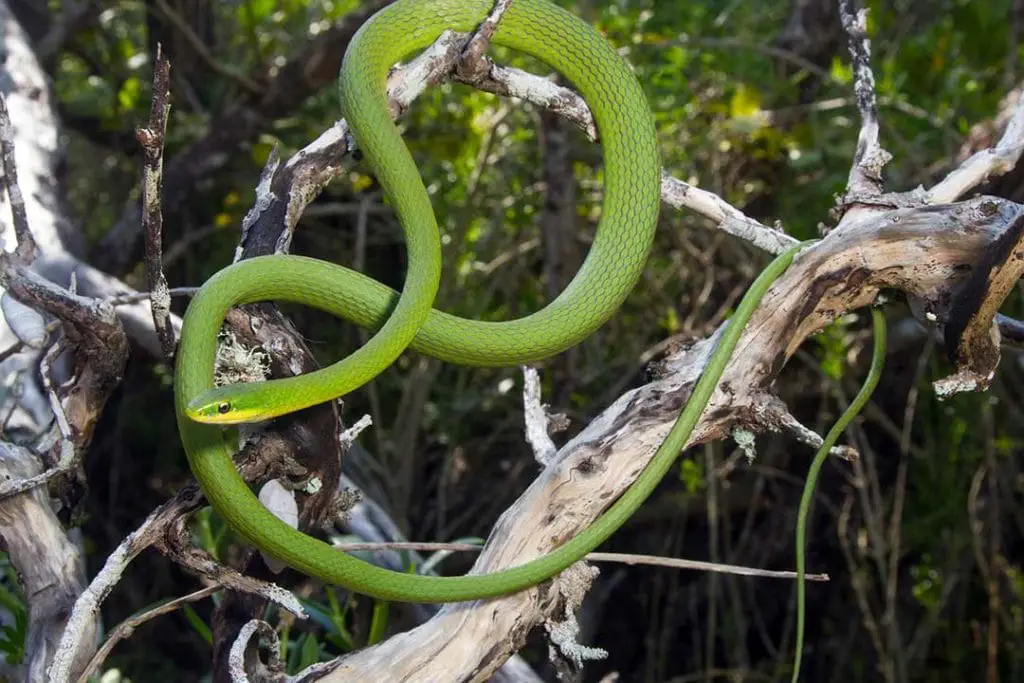
The rough green snake (Opheodrys aestivus) can be found in the Piedmont and Coastal Plain but avoid high elevations in the mountains.
It is the only true green snake in georgia, other green snakes native to georgia are more of an olive or darker green shades.
They are slender snakes that can reach up to 32 inches long. They are bright green with light bellies and keeled scales.
They are primarily arboreal and eat invertebrates like spiders and insects.
Corn Snake
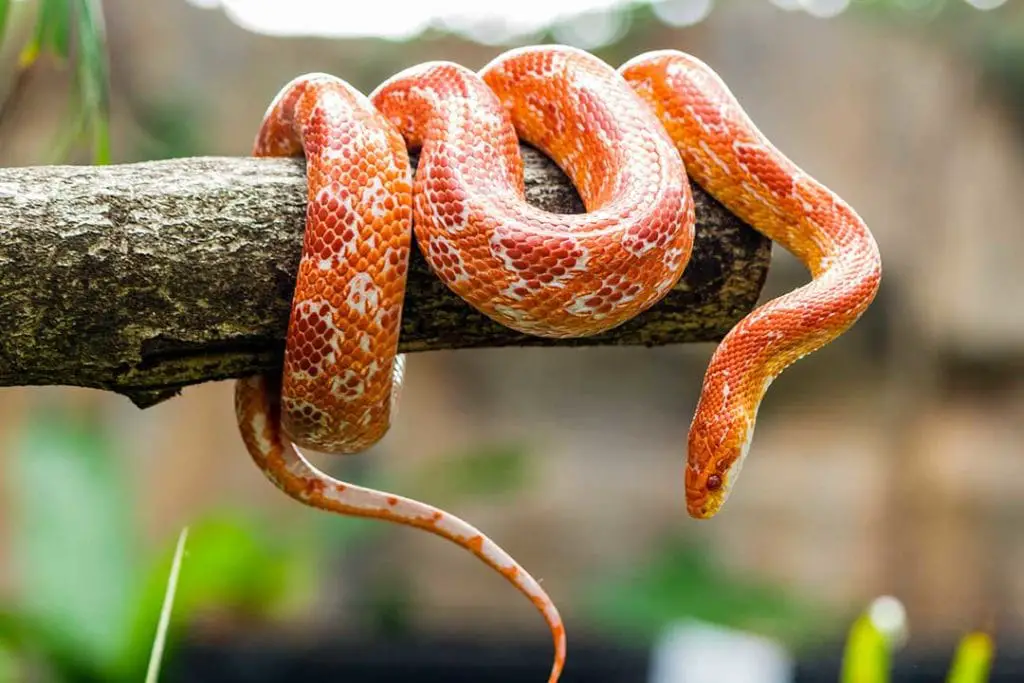
The corn snake (Pantherophis guttatus) is found most commonly in the Coastal Plain, but can be found throughout the state.
They are between 30 and 48 inches long on average. Wild corn snakes are typically orange, brown, or gray with reddish or brown saddle markings bordered in black.
The belly has a checkerboard pattern. They prefer dry habitats with plenty of animal burrows. They spend most of their time hiding under cover but will climb trees.
They can also be found near human buildings like barns. They eat mammals, birds, and reptiles. Corn snakes are a common pet snake, easy to care for and docile. but it is protected in Georgia, making owning one likely illegal.
Eastern Rat Snake
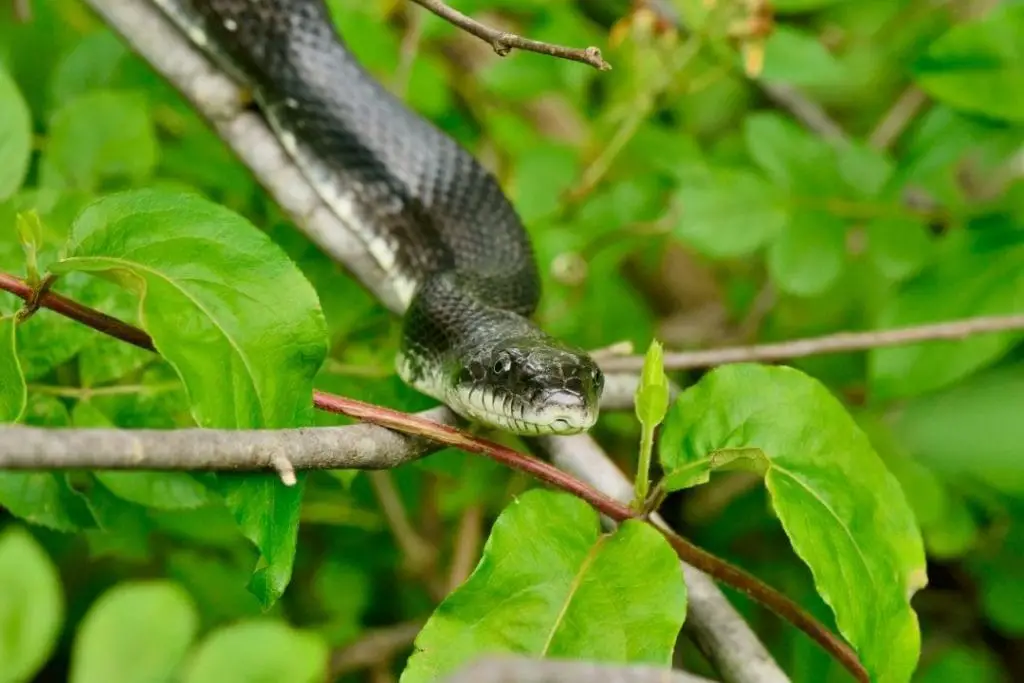
The Eastern rat snake (Pantherophis alleghaniensis) is found primarily in the south of Georgia. They are typically between 42 and 72 inches long.
They have a variable appearance, but many adults have stripes.
Rat snakes live in a wide range of habitats and will eat anything they can catch such as mammals and reptiles.
Gray Rat Snake
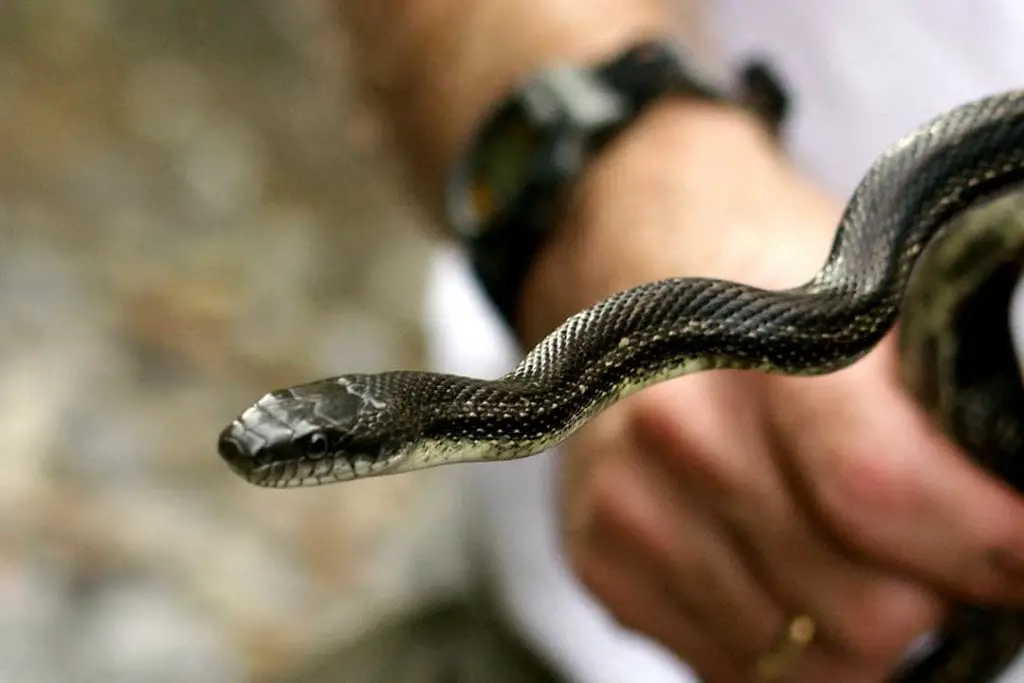
The gray rat snake (Pantherophis spiloides) is found most commonly in the north of the state.
They are typically between 3 and 6 feet long and are typically some shade of gray.
Gray rat snakes live in forests and are excellent climbers. They typically eat mammals and birds with juveniles preferring lizards.
Pine Snake
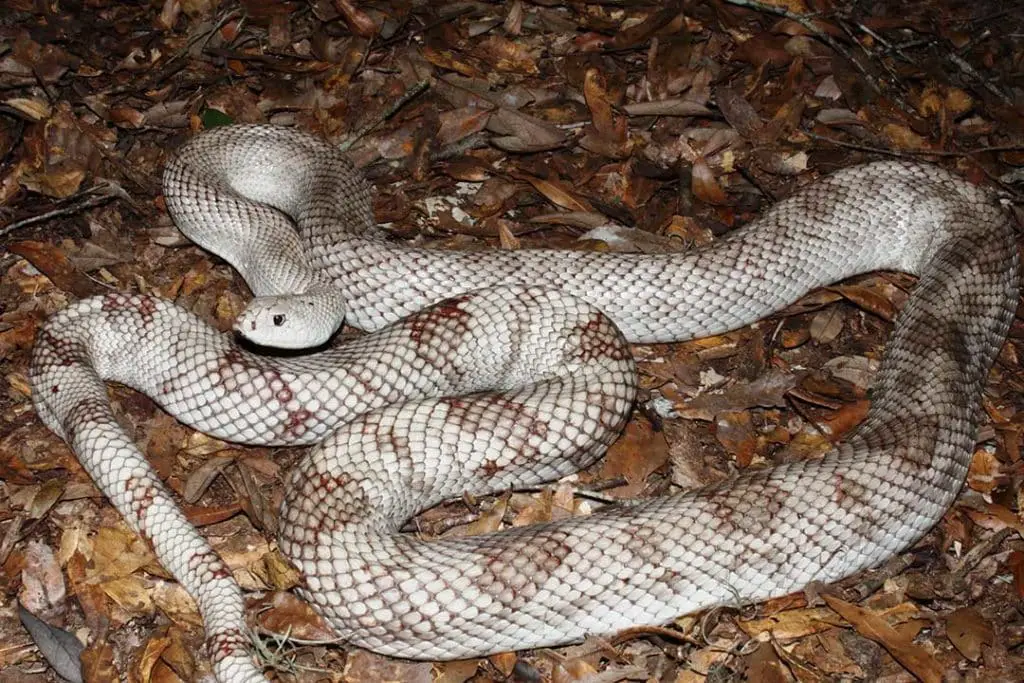
The pine snake (Pituophis melanoleucus) can be found throughout the Coastal Plains with some populations in the mountains.
They are 48-66 inches long and have a light background color with darker squarish blotches.
They prefer dry habitats and are considered to be threatened in Georgia.
Common Kingsnake
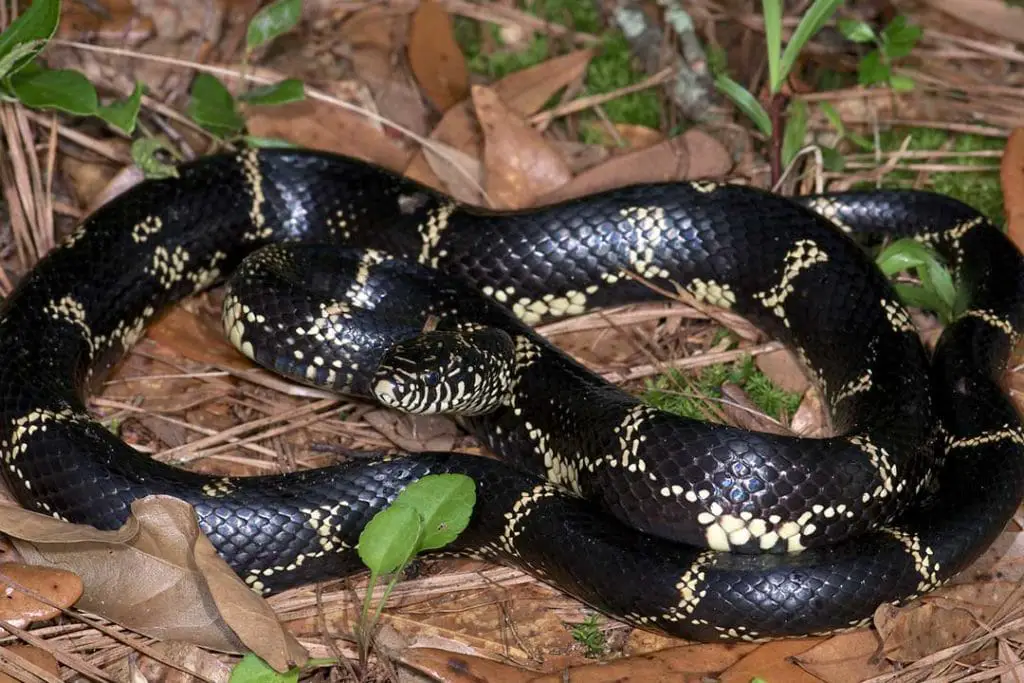
The common kingsnake (Lampropeltis getula) is the classic king snake found throughout all of Georgia.
They are between 36 and 48 inches long with shiny black scales with white or yellow “chain” markings. They live in many habitats and eat a wide variety of prey including venomous snakes.
Black King snake

The black kingsnake (Lampropeltis nigra) is found in the northwest of Georgia. They are typically 35-48 inches long but can max out at 72 inches.
It is a shiny black with widely-spaced light freckles.
Mole King snake

The mole kingsnake (Lampropeltis calligaster) is found primarily in the Piedmont.
They are between 30 and 40 inches long and are typically brown to gray with reddish spots that fade with age.
They are rarely seen borrowers and have a wide diet like other kingsnakes.
Scarlet King snake
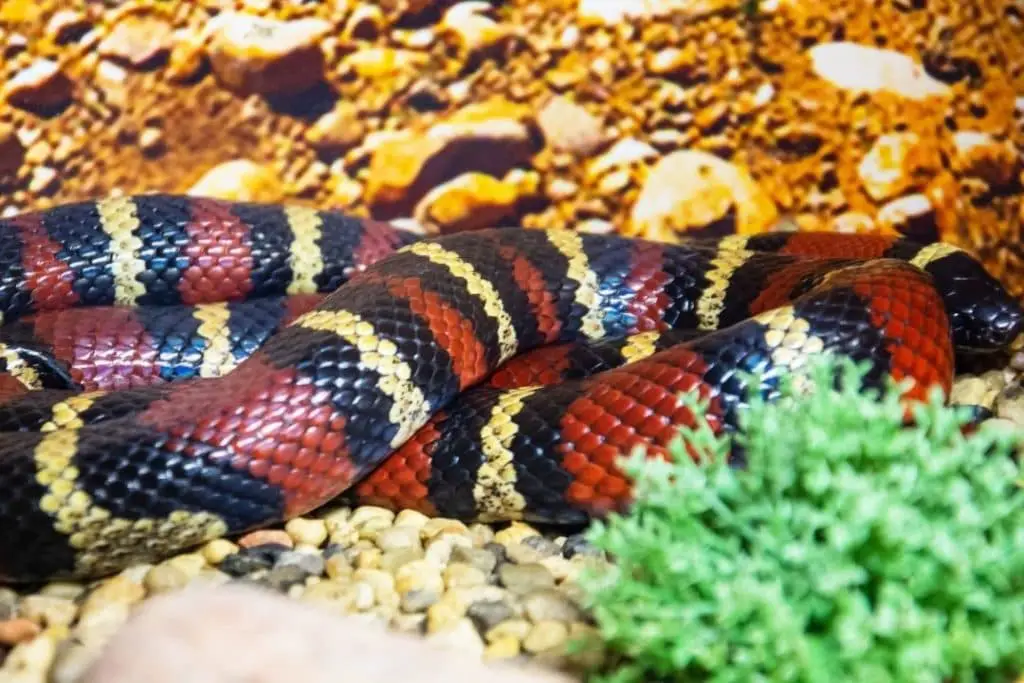
The scarlet kingsnake (Lampropeltis elapsoides) is found over most of the state but is most common in the Coastal Plains. They are between 14 and 20 inches long and are a mimic of the coral snake.
They have bands of red, yellow, and black with the yellow only touching black. This can help tell them apart from coral snakes.
They normally stay underground. They eat lizards, but will also eat other snakes and mammals.
Eastern Milk Snake
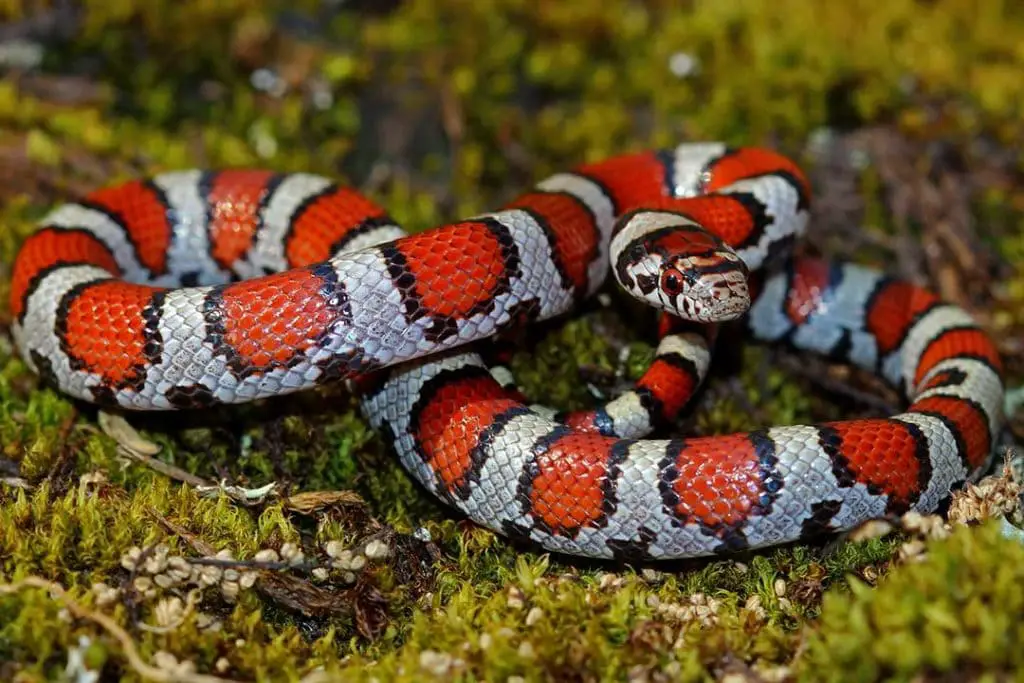
The Eastern milk snake (Lampropeltis triangulum triangulum) is only found in the northwestern mountains.
They are between 24 and 35 inches long with a gray to tan background and brown blotches bordered with black.
Eastern kingsnakes live in a wide variety of habitats and are typically found hiding under rocks or logs.
Scarlet Snake
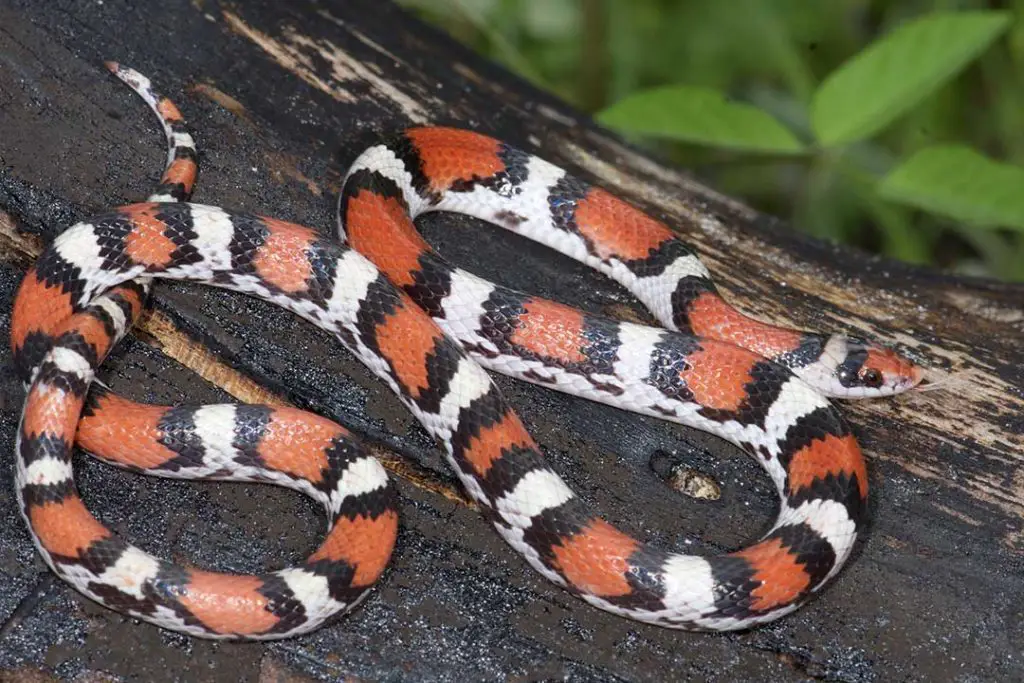
The scarlet snake (Cemophora coccinea) is found in all of Georgia aside from the mountains.
They are up to 20 inches long and have red, black and yellow or white bands. Their bands do not extend to the belly which is typically pale.
They prefer forests with dry and sandy soil. They eat mainly eggs but will consume small animals on occasion.
Southeastern Crowned Snake
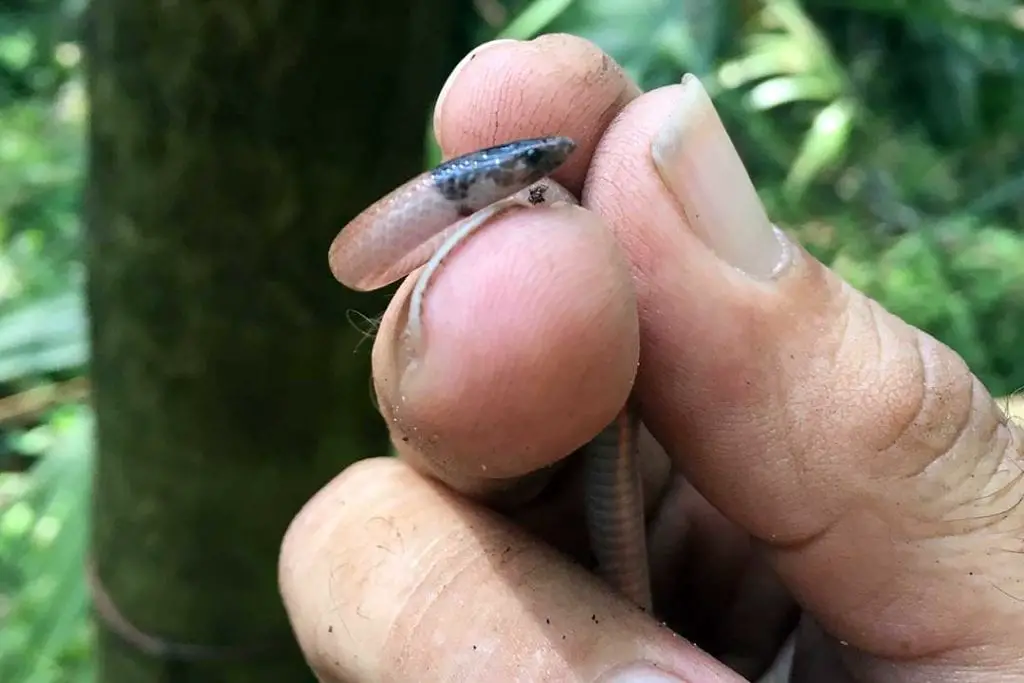
The Southeastern crowned snake (Tantilla coronata) are found primarily in the northern part of Georgia.
They are between 5 and 9 inches long and are tan to brown with a black head and band around the neck.
They are found under debris and eat insects with centipedes being a favorite.
Florida Crowned Snake
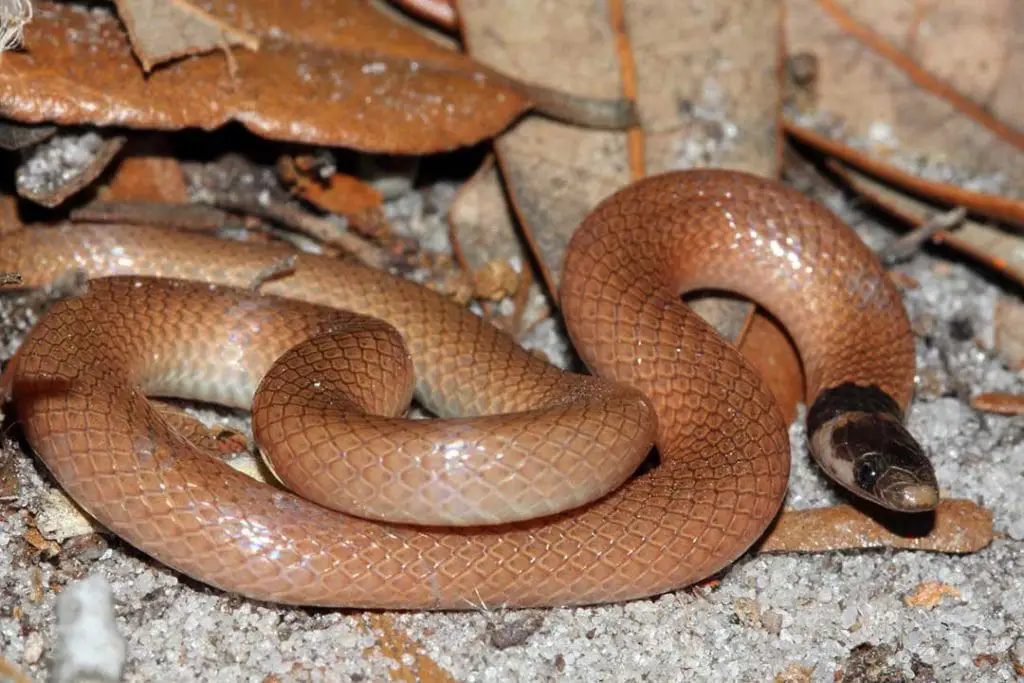
The Florida crowned snake (Tantilla relicta) is only found in the extreme south of Georgia since they live mainly in Central and Northern Florida.
They are 7-9 inches long and are tan to light brown with a black head. They are found in well-drained soils and are rarely seen since they live underground.
Eastern Indigo Snake
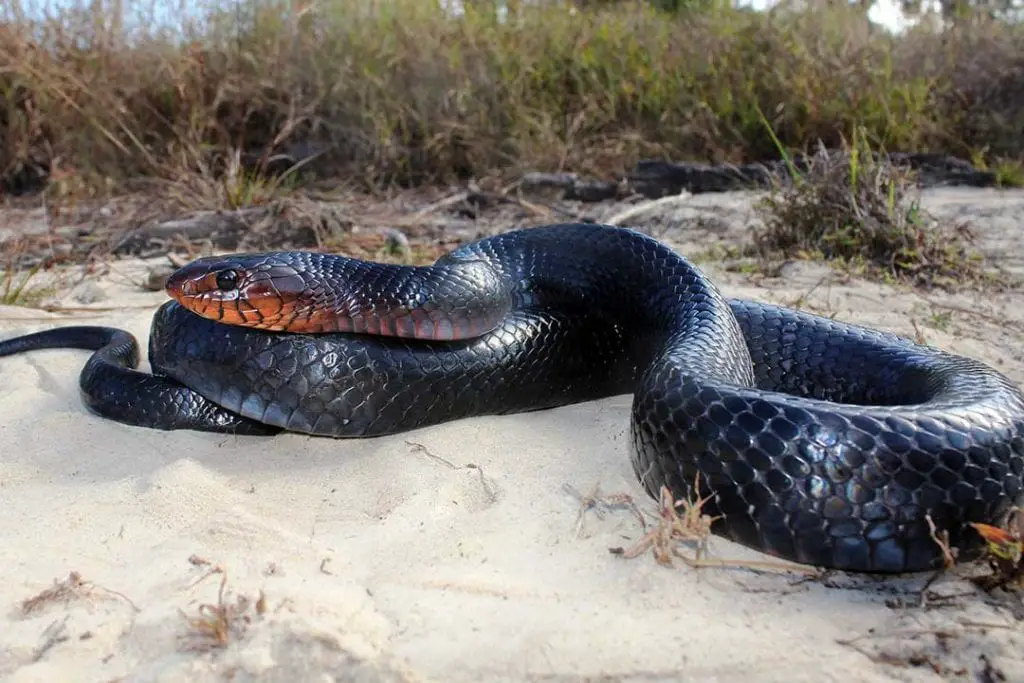
The Eastern indigo snake (Drymarchon couperi) is found in southern Georgia. They are the longest snake in the United states and can be 60-84 inches long.
They are a bluish-black with reddish or orangish-brown chins. They live only in xeric pine-oak forests with populations of gopher tortoises since they spend the winter in the tortoises’ burrows.
They eat a wide variety of prey that can include young gopher tortoises.
Brahminy Blind Snake (non-native)
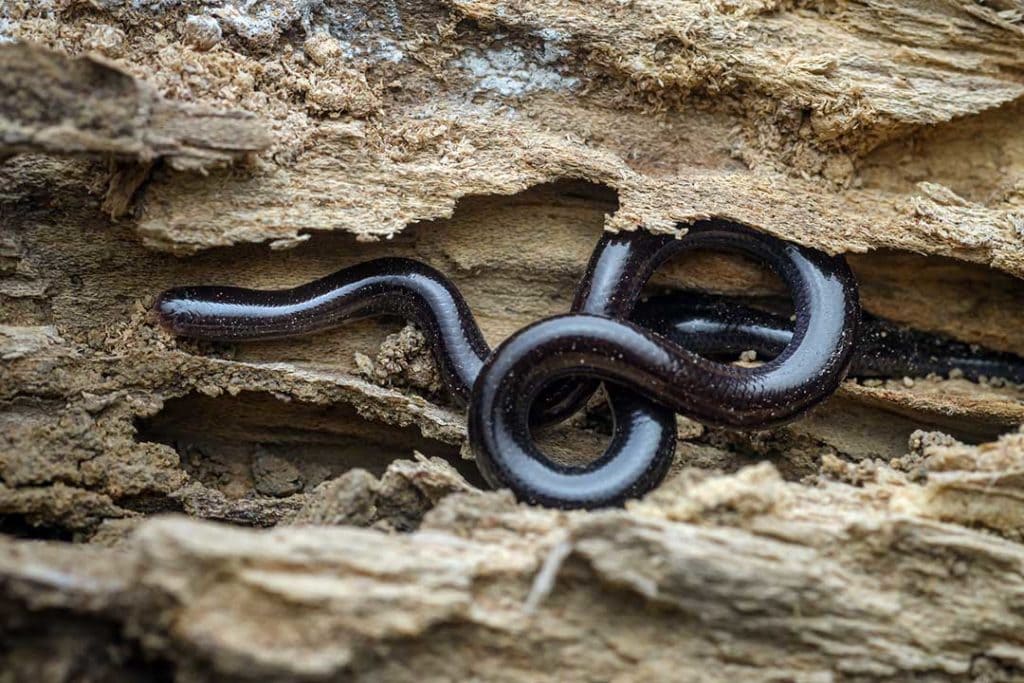
The Brahminy blind snake (Indotyphlops braminus) is not native to Georgia but was introduced from the soil of imported plants.
They are native to Southeast Asia. They are 4-6 inches long and are shiny with a purple or gray color.
They have blunt heads and tails that are hard to distinguish. They eat the eggs and larvae of termites and ants.
Venomous Snakes
These snakes are the venomous species found in Georgia. They can cause serious harm or even death if their bites are not treated.
When you are in the habitat of these species, always wear boots and long pants.
Step into leaf litter or near logs carefully and listen for hissing or rattling. If you hear a snake, freeze until you locate it and back away.
Venomous snakes will not pursue you and will flee from you if given the chance. If you are bitten, seek medical help.
The six venomous snakes in georgia are:
Copperhead
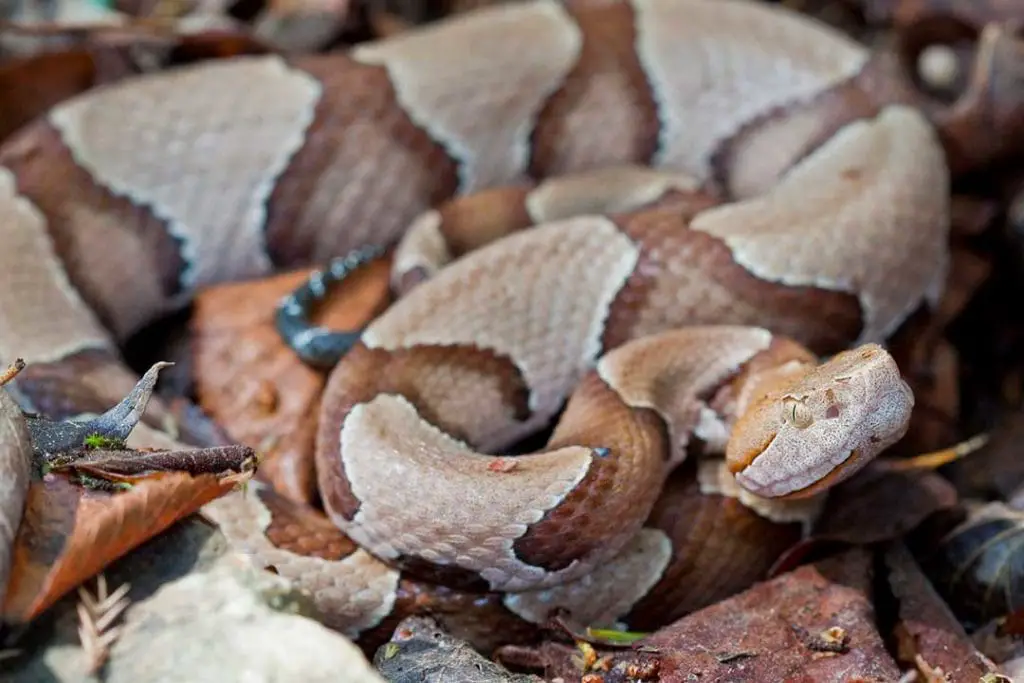
The copperhead (Agkistrodon contortrix) are found throughout most of Georgia aside from the south.
They are 24-40 inches long with triangular heads and elliptical pupils like a cat. They are tan to brown with hourglass-shaped markings. They prefer forested habitats and eat a wide variety of prey.
Fatalities from their venom is rare but they will cause severe pain anand potential scarring. These snakes only bite if harrassed.
Pigmy Rattlesnake
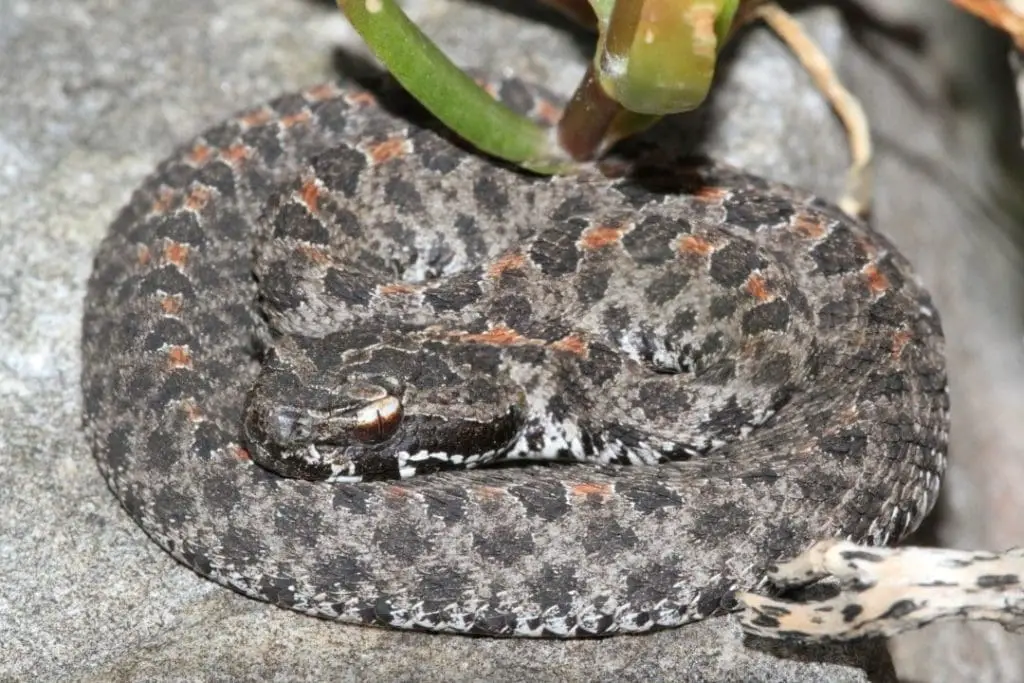
The pigmy rattlesnake (Sistrurus miliarius) is found in nearly all of Georgia aside from the northern border. They are 14-22 inches long and can rarely be heard when they rattle.
They have a variable appearance depending on the subspecies. The dusky subspecies is typically dark, while the Carolina subspecies can be gray, lavender, tan, or even orange.
They inhabit a wide range of habitats where they hide in leaf litter to ambush their prey.
While they struggle to inject enough venom to cause death, they can cause major damage to a human. Always wear boots and loose pants in areas that may have this species.
Timber Rattlesnake
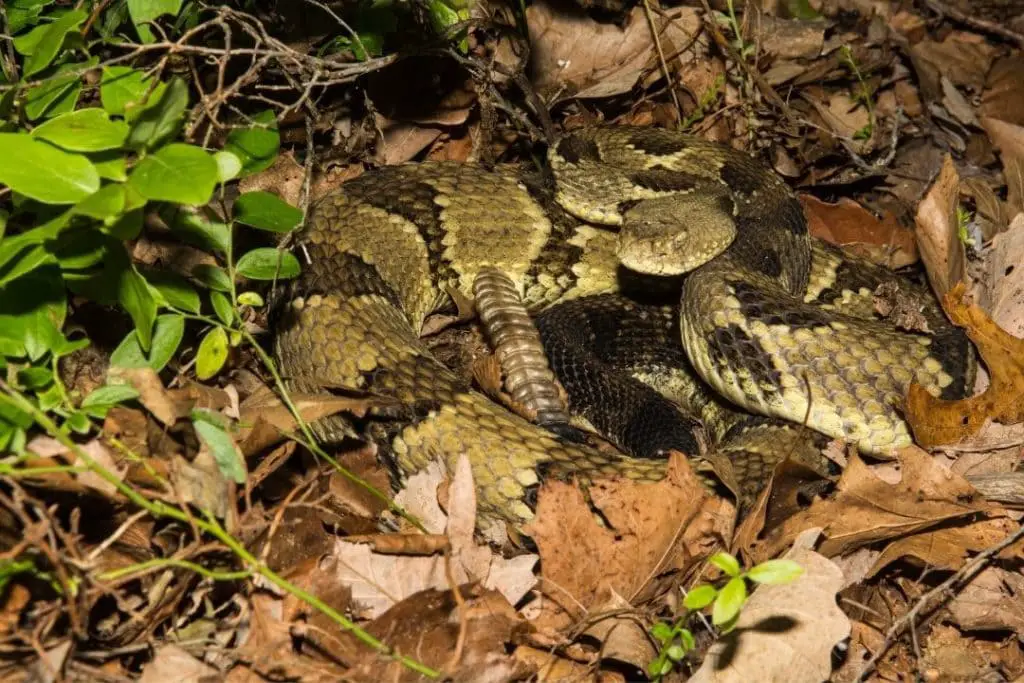
The timber rattlesnake (Crotalus horridus) is found over all of Georgia in hardwood forests.
It is 30-60 inches long with thick bodies and are gray, brown, yellow, tan, or black with black tails and chevron patterns.
They only bite if disturbed but any bites need medical attention.
Cottonmouth (water moccasin)
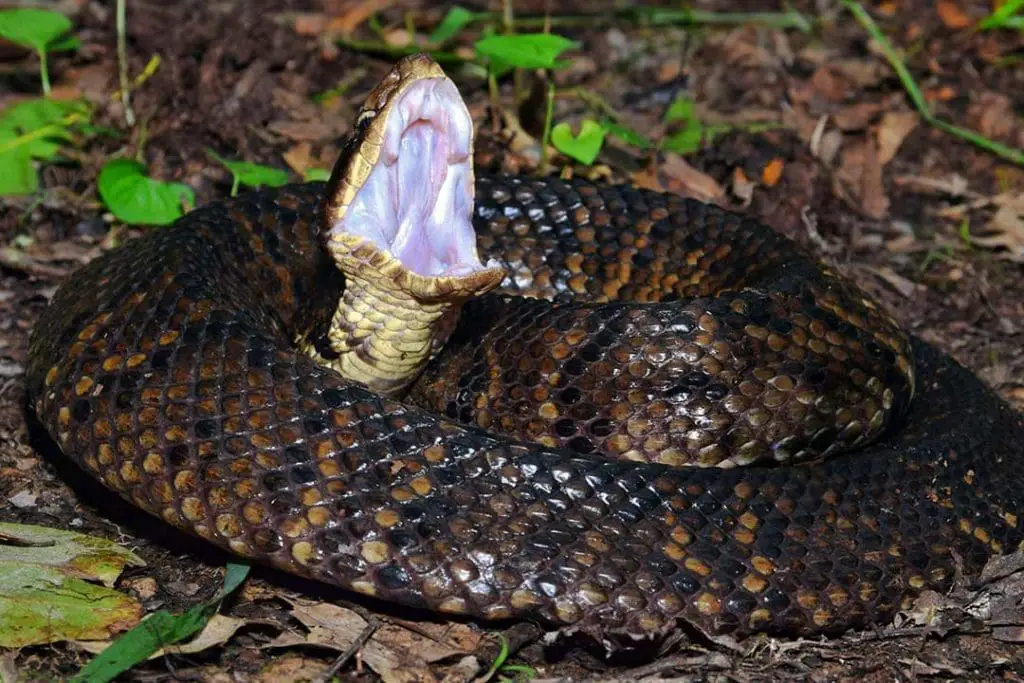
The cottonmouth (Agkistrodon piscivorus) or water moccasin is found in most of Georgia aside from the northeast.
They are between 24 and 48 inches and have large jowls that help set them apart along with a white interior to the mouth that they display when threatened.
They can be brown to tan with crossbands or little patterning. They are rarely found far from water. They are not aggressive and only bite as a last resort.
Eastern Diamondback Rattlesnake
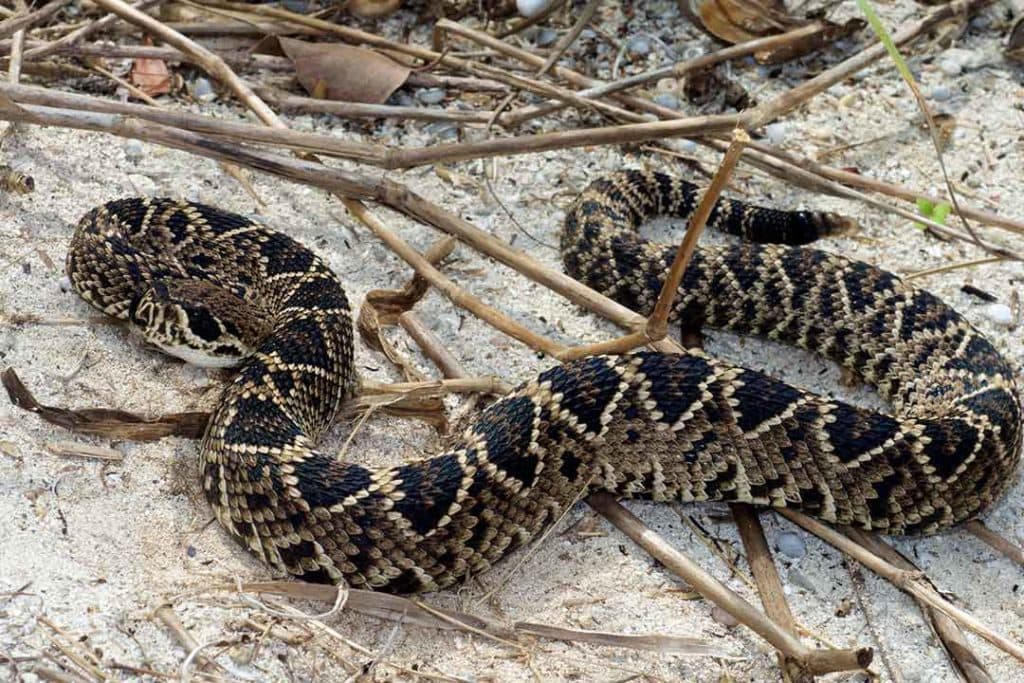
The Eastern diamondback rattlesnake (Crotalus adamanteus) is found in the southern half of Georgia.
They are 33 to 72 inches long and are brown, tan, or yellow with the characteristic diamond pattern.
They prefer dry habitats and may be at risk of extinction.
Eastern Coral Snake
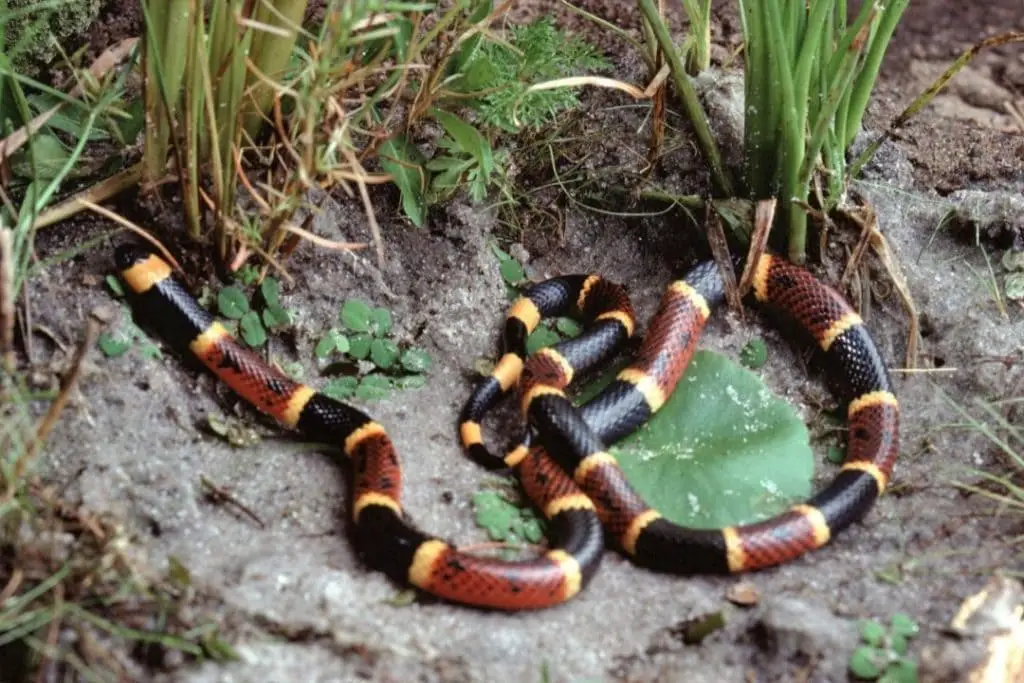
The Eastern coral snake (Micrurus fulvius) is found in southern Georgia. Eastern Coral snakes are 18-30 inches and have red, yellow, and black with the red touching yellow.
Coral snakes are rarely seen since they are burrowing snakes. Their venom is very dangerous and needs immediate treatment to survive.
Conclusion

We hope this helped you learn more about the snakes of Georgia. If you have any questions or comments about georgia snakes, please leave them below.
Image credits:
FWC Fish and Wildlife Research Institute, Peter Paplanus, Andrew Hoffman
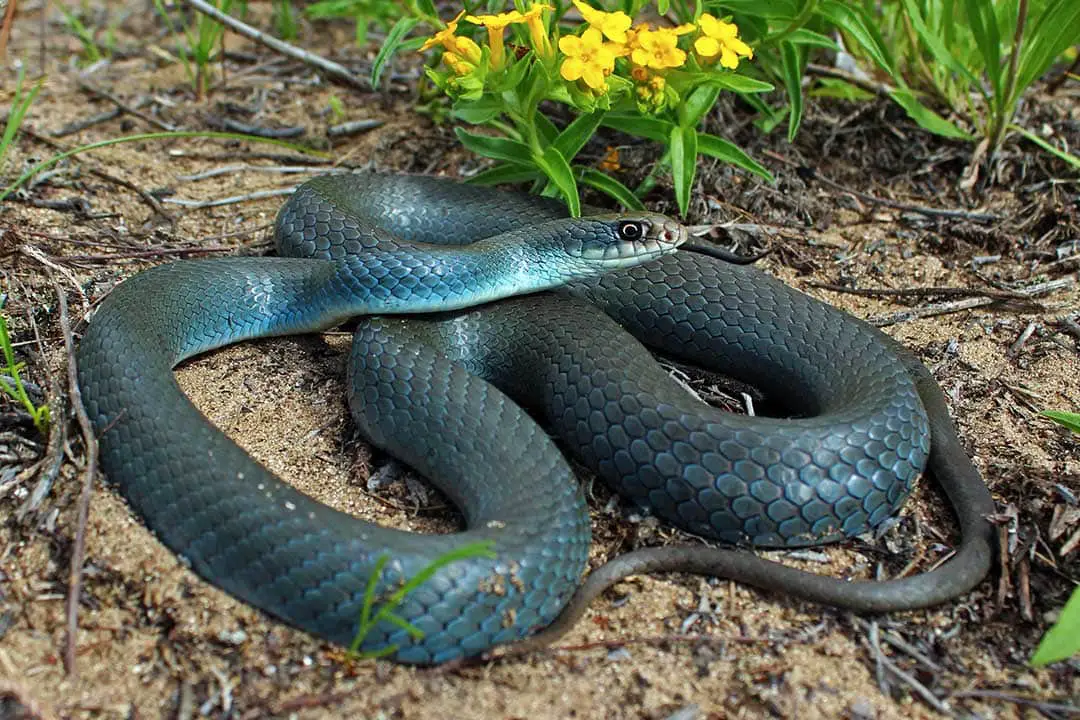
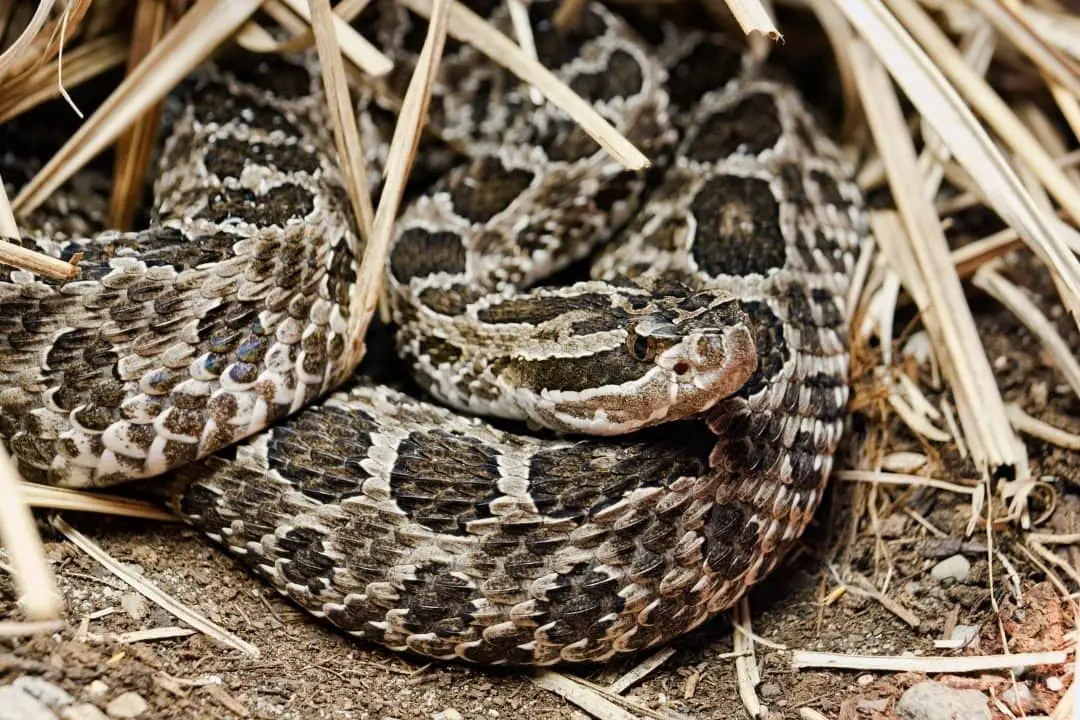
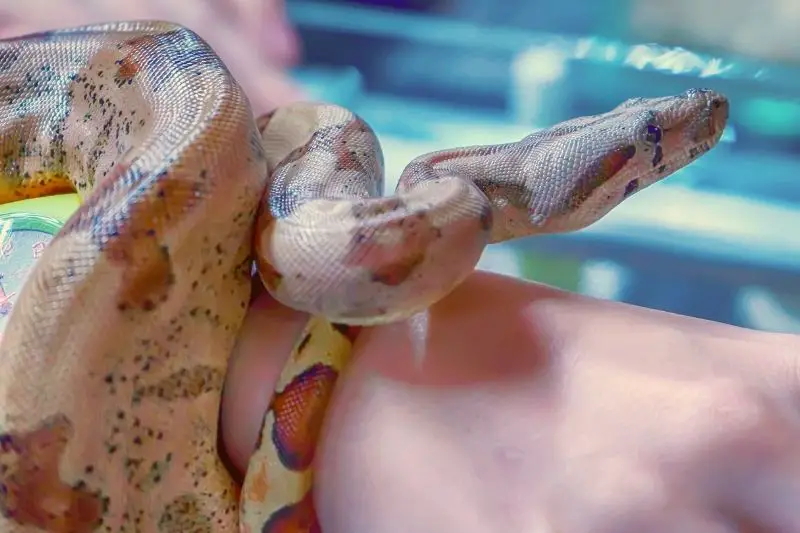
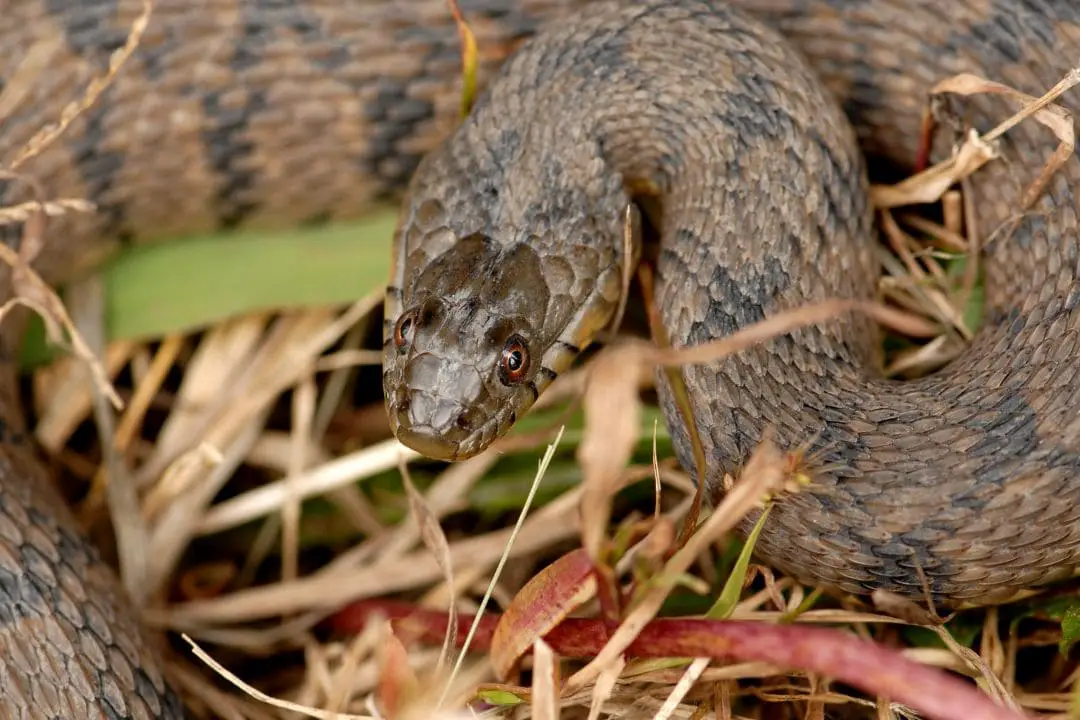
Do you know any stores in the Commerce GA area who sell black kingsnakes to use as pest control method?
I just found a Pygmy Rattler on my porch this morning digesting meal …I’m assuming one of the hundreds of geckos in my yard. It was small..only 8-9″. I had no idea what it was or that it was venomous. I took pics and then looked here to identify it.